If you would like a printed copy of any of our back issues, then they can be purchased on Farm Marketplace. You can also download the PDFs or read online from links below.
-
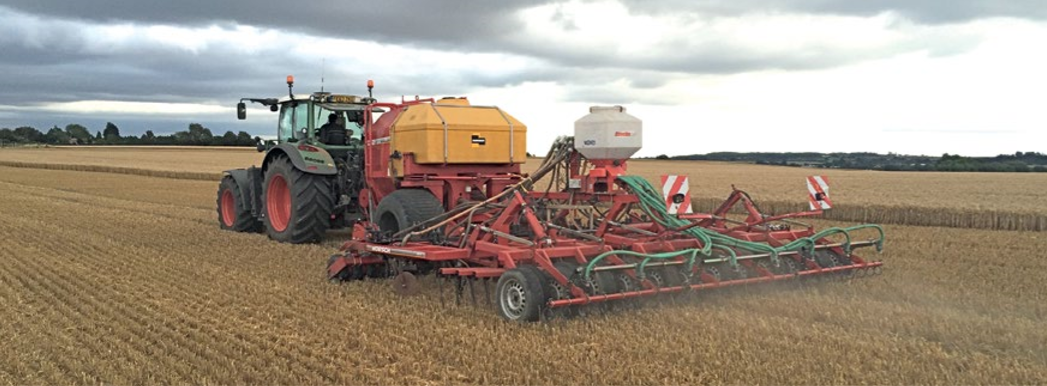
How To Start Drilling For £8K
Clive Bailye’s seed drill of choice is his 6m John Deere 750A , which has been used exclusively for 3-4 seasons. Last year, with an increased acreage, the founder and publisher of this Direct Driller magazine thought a second seed drill was necessary. Having just the one machine was a risk and in a difficult season would mean drilling was delayed. He looked around and found a good condition Horsch CO6 tine drill advertised in Germany.
Words and pictures by Mike Donovan
After delivery he rebuilt the coulters to a narrow profile so as to reduce soil disturbance. He says the tine drill is very useful driling after straw crops such as osr and also through the straw on second crop cereals.
Buying the drill from a German farmer was not particularly complicated, and provided him with a higher spec machine than Horsh sell in the UK. The seed dart tyres are much wider, and the machine is fitted with blockage monitors as well as full width front packers and also a liquid fert application system.
A sheaf of photos were taken, and Clive then asked for some of specific parts to show wear. The deal was done at under £5,000 which Clive says is the market value of these machines which are too large for small farmers to buy. Original owners like to buy new and sell when the machine is still in good condition.
Narrow tines with wear tiles
@Clive knew he wanted to make changes, substituting the Horsch tines and coulters for something far narrower, and has ended up getting his own design of tine made, which has a wear tile made from Ferobide, far harder than tungsten. The drill is on the farm primarily for osr and 2nd crop cereals drilled into chopped straw and the 25cm spacing is okay for these crops.
Comments on Clive’s on-line forum, TFF, said the drill many not be so good with beans, as the slot is a mere 12mm wide. And in barley the spacing may well be too wide as it needs to be thick. Clive points out that the seed pipe can actually be a bit wider than 12mm as it is in the shadow of the point. It would be good to have the option of using it for beans.

Above left: The cheap CO6 is being calibrated ready for its first outing

Above right: The adapted Horsch is being filled by the home built drill logistics trailer with seed and liquid starter fert.
Getting around the German instructions
The Horsch came, of course, with a control box and instructions in German. More on-line discussion revealed that English instructions were available on the Horsch website, and another explained that Horsch was sourcing some of these parts from Agton in Canada anyway. Zealman from New Zealand explained that the button marked with callipers should be held down for around 5 seconds. The menu is where you adjust the tramline sequence, valve layout and row numbers.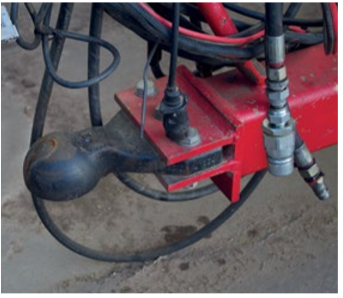
Ball hitch is a continental standard and provides a positive connection between tractor and drill

The Stocks Wizard has a rotor modified for Avadex which otherwise leaks everywhere
A Stocks Wizard is on the back of the drill and used for Avadex. Here again the knowledge of actual farmers is helpful. Alistair Nelson warned that the rotor and the surrounding shroud need to be changed, and he got good advice “from Rick at Stocks”. Clive has the same setup on the 750A and says that the Avadex leaks everywhere unless the modification is made. The drill was acquired and modified in 2016 and the results have been excellent.
The machine went through the residue without many problems and having the second drill has meant more timely planting. Clive has shown that moving into No-Till is not the expensive exercise so many farmers think it might be. The total cost, after modifications which included replacing all tines and coulters, was under £8,000.
Author Mike Donovan writes: we have featured a number of home made direct drills in @Practical Farm Ideas, and are always interested in seeing more. Please contact mike editor@farmideas.co.uk or 07778877514.
-

Farmer Focus – Andy Howard
Farming in Transition

This year on our farm we have used no tillage, 40% less Nitrogen fertiliser than standard practice, over 50% less fungicides and only one insecticide on a 3ha field of Spring linseed. Has getting to this stage been easy? No. Has it all gone perfectly? Definitely not.
It has been a hard road we have taken to get to this stage over the last 18 years with many lessons learnt and many more lessons to come. Transition is difficult and you must be prepared to fail. When I visited Gabe Brown in North Dakota he said, “if he didn’t fail at least once a year he wasn’t trying hard enough!” When we started reducing tillage in 2001 there weren’t many people to advise us. The same was true when we grew our first cover crop a few years later and now we are reducing inputs there are very few people to advise us.
So, we had some glorious failures, this though now can be avoided as there is much more information out there now, as long as you speak to the right people. I think practising farmers are the best option. So why are we going through this transition? For me there are a few choices going forward into the future. We go for a high input/ high output system and probably fail on the high output part most years! We can go organic, I have had the pleasure of visiting many great organic farmers, but the system is currently not for me due to too much cultivation, potentially high weed burdens and large yield variation.
On my Farm I believe the best economic and environmental route is a hybrid system of the two.
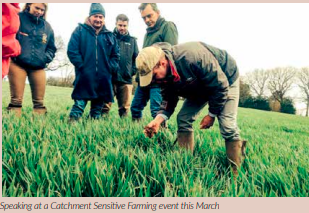
Judicious use of pesticides and fertilisers with the aim of reducing their use year on year by using cultural and Agroecological methods. This will hopefully maintain yields but at the same time reduce cost per tonne produced, reducing the farms exposure to weather and market variations. There are a few other reasons why I am choosing the low input system over the high input system: firstly, I don’t believe we have a choice. Consumers, climate change activists, water companies, The Environment Agency and many others are demanding produce that is grown with less fertiliser and “cides”, these demands are getting louder.
The current drive to high input/high output cereal farming will I believe become uneconomical, possibly illegal, if the polluter pays principal is applied. Secondly the chemical tools in our armoury are quickly being removed and the ones left have increasing resistance to them, alternatives methods must be found. Finally farming this way is far more interesting. The conventional way of farming hides many issues with plant and soil health by covering them with fungicides and applying excess amounts of fertiliser. It is not until you reduce or remove their use that you start to see differences in terms of plant health between fields and within fields, then you need to try to work out the root cause of the differences.
An example of this, this year, our only areas of wheat affected by BYDV are on the sandy soil which became Manganese deficient in January, which then made the wheat attractive to aphids. So next year we will have to improve nutritional management on the lighter ground. Interestingly these same areas are the only place we have seen excessive disease in the wheat, no wheat had a fungicide until flag leaf. I personally think the deficiency of Manganese led to BYDV which then stressed the plant allowing disease to enter the crop.
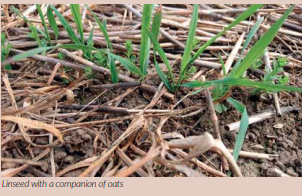
I seem to spend a lot of my time being told by people that what I am doing is not possible. Most magazines you read will tell you of the impending disaster if you dare omit a pass with a chemical. If it wasn’t for my experiences on my Nuffield Scholarship, seeing amazing farmers around the world who have drastically reduce inputs while maintaining or increasing their yields, I may have had doubts and returned to the standard current practices. What did they all have in common? Diversity of cropping and a whole farm systems approach. There is no way I am going back now!
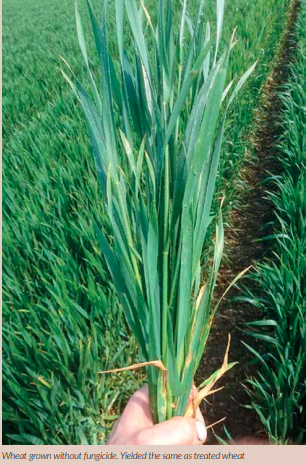
The major advantage of the standard practices is that it’s easy. Your agronomist gives a recommendation, you send out the sprayer to carry out the orders and you don’t even need to enter the field. This is not true of a low input regenerative system of farming. You need to be out there regularly checking your crops, observing differences, digging holes and sometimes have big balls to say no to your agronomist. Every year is different, standard “T” timings and products do not cut it. Achieving a successful low input system starts with the soil. A healthy soil grows a healthy plant which in turn needs less fertiliser and is more resilient to pest and diseases.
This whole farm systems approach is knowledge intensive not input intensive. You need diversity and need to be flexible, if you think you can just cut out inputs and all be fine you could get a shock. Adding diversity to our cropping for me is the most important strategy we need utilise more going forward. This year we have used oats as a companion crop for spring linseed, as I observed last year that the linseed growing in wild oat patches were less affected by Flax Flea Beetle. The Innovative Farmers trial here has shown that where linseed was planted with the oats, we have about 80-100 more plants per m2 survive the Flea Beetle onslaught compared to the monocrop Linseed. A great example of Diversity in action.
Unlike organic farming this reduced input approach doesn’t receive transitional payments or receive a premium for your produce and so for it to work costs need to be reduced and good advice needs to be taken, especially in the early years to avoid the big mistakes that we have made here on our farm. An issue with the whole farm systems approach is that it is complicated so their needs to be an understanding of the knock-on effects of each decision. During the last couple of years of travelling the country and talking at farming events I have noticed a real growing interest in reduced input farming. I was getting many questions on Notill, cover crops, intercropping and input reduction strategies so I thought there was an information gap that needed to be filled.
Like most farmers they prefer to listen from other farmers and learn from their successes and failures rather than experts with no skin in the game who can be driven by other vested interests and agendas. As a result, I have joined Abacus Agriculture as a consultant. Abacus are a group of independent consultants and farmers, who advise on transitioning to organic farming, agroforestry and soil management. Adding myself to the group seemed to make obvious sense, we are all advising on transitioning in farming and have much we can learn from each other. So if you think you want to start this transition take a look at our transition tool by scanning the QR Code.

Join the growing group of farmers leading the way to a sustainable farming future and making farming exciting again!
-
Earthworm Engineers
Written by Eliza Jenkins Community Development at Sectormentor for Soils. Eliza helps to nurture the community at
Sectormentor for Soils – a system that enables you to monitor and assess soil health on your farm.Earthworm Engineers #1: Ecosystem Services
Many fascinating papers on earthworms have recently been open access to online readers of the European Journal of Soil Science, so we chose four of our favourites to summarise into a series on the on-farm heroism of earthworms.
#1: A review of earthworm impact on soil function and ecosystem services
First, this comprehensive review reminds us of the many reasons why earthworms are farmers’ best friends. We can separate earthworm species into three categories: surfacedwelling worms (epigeic), deep-burrowing worms (anecic), and network-creating worms (endogeic). All three of these worm types play an important role. In their soils, earthworms are considered ‘ecosystem engineers’, and they earn this title for several reasons…
First, earthworms actually create soil! Worms feed on leaf litter on the soil surface then bury the organic matter into the soil, allowing it to be mixed and decomposed, and eventually incorporated as soil organic carbon within soil aggregates. This same process also allows for nutrient cycling in the soil, which is helped by the soils’ increased surface area due to the networks of earthworm channels. In eating soil and moving it around, worms have even been shown to heal soils that are polluted, by breaking down the contamination.
The presence of earthworms improves the soil structure, as the pore network created allows for a higher ‘bulk density’ of stable aggregates. This pore network can also improve plant root penetration, and the water infiltration ability of the soil, by creating space for the water. The increased drainage and the creation of water-stable soil aggregates can also reduce runoff on farms, as well as soil erosion by up to 50%. As earthworms burrow into the soil and bury organic carbon, they also help the process of carbon sequestration – the locking up of of CO2 from the air into soil organic carbon (SOC) in the soil.
But this soil carbon can be re-released again as greenhouse gases, especially when the soil is disturbed during ploughing. The process of building up carbon in the soil is complex, and varies depending on how much organic matter is available to the worms on the soil surface. Considering all of these earthworm endeavours going on beneath our feet, it’s unsurprising that this paper finishes by reporting that the presence of earthworms has been widely shown to improve the growth of plants above ground. Now it’s clear why they’re considered the engineers of their ecosystem!
Earthworm Engineers #2: Arable Farming and Earthworm Populations
Many fascinating papers on earthworms have recently been open access to online readers of the European Journal of Soil Science, so we chose four of our favourites to summarise into a series on the on-farm heroism of earthworms.
#2: Effects on populations of earthworms of different methods of cultivation and direct drilling, and disposal of straw residues
Our second installment comes is a paper that makes some really interesting conclusions about the effects of cultivation on earthworms in topsoil. They tested the number of earthworms over four years on direct-drilled fields that were sprayed with herbicide before planting, and ploughed fields (of varying soil types). They found earthworm populations were consistently greater in the direct-drilled soils compared with ploughed soils, although deep-burrowing species were affected similarly in both treatments. They also test the effect of spreading mulch on the fields compared to burning straw residue, and find (unsurprisingly) that earthworm populations were greater in fields where straw residue was spread rather than burned, particularly in surface feeding species. This surface debris becomes an important food source for the worms, and makes their diet more stable.
It is also suggested that the extra earthworm channels created under no-till soils may help to reduce any compaction in the soil, as well as distributing organic matter and facilitating drainage. The reduction in compaction is also likely due to increased plant root penetration within earthworm channels.
The three key tenets of regenerative agriculture are maintaining soil cover, minimising soil disturbance, and diversifying crop rotations. This paper presents clear scientific evidence of the positive influence of minimal cultivation, and soil cover (as mulch) on the earthworm community, and as we learnt in the first edition of our series, earthworms have a significant influence on the health of soils. All the more reason to farm with a regenerative approach and encourage our earthworm friends.
Earthworm Engineers #3: Organic vs Conventional Symptoms
Many fascinating papers on earthworms have recently been open access to online readers of the European Journal of Soil Science, so we chose four of our favourites to summarise into a series on the on-farm heroism of earthworms.
#3: The impact of soil carbon management on soil macropore structure: a comparison of two apple orchard systems in New Zealand
When testing for earthworm populations, the researchers consistently found more earthworms in the organic soil compared with the conventional soil. They also reconstructed the 3D ‘macroporosity’ structure of both soils using X-rays, and again found greater macroporosity within the organic soil compared to the conventional soil. This isn’t a coincidence! Macroporosity is defined as the network of pores with a diameter of over 0.3 mm in the soil, and earthworms are known to create these kinds of channels. This increased macroporosity is important for several reasons. First, it is known to increase the rate that CO2 in the atmosphere is locked up as soil organic carbon (SOC), which both increases soil fertility and also has potential to reduce the rate of climate change.
As expected, this study then found that the organic orchard had a 32% greater SOC content than the conventional soils. Increased macroporosity also improves the soil structure, as the stability of soil aggregates is increased, which allows more microbes to live in the soil. Denitrification rates are known to increase in anoxic, water-logged soils, which leads to increased emissions of N20, a gas that contributes to climate change. As a result, increased macroporosity reduces denitrification in the soil, by allowing oxygen to penetrate into the topsoil, and reducing the chances of water logging. It’s amazing to see evidence of how organic techniques allow our earthworm friends to flourish, and how positive their presence is orchard soils.
Earthworm Engineers #4: Manure and Earthworm Populations
Many fascinating papers on earthworms have recently been open access to online readers of the European Journal of Soil Science, so we chose four of our favourites to summarise into a series on the on-farm heroism of earthworms.
#4: Quantifying dung carbon incorporation by earthworms in pasture soils
This study looks at the effect of different earthworm communities on the amount of soil carbon (within dung applications) shifted into the soil. They tracked this process by labelling the carbon with isotope tracing, which is a clever technique that gives a really specific picture of where exactly the carbon is moving to. The three main earthworm types were tested in different treatments: surface-dwelling worms (epigeic), deep-burrowing worms (anecic), and networkcreating worms (endogeic).
First, the researchers found that with increasing inputs of dung, the abundance of earthworms tested also increased, presumably because the worms had a more consistent food source in these pots and could flourish.
Most of the tracked carbon was found in the soils top layer (0-75mm), although when the earthworm population included deep burrowing (anecic) earthworms, carbon from dung was often found at depths of up to 300mm, which shows just how effective these worms are at burrowing materials from the soil surface into its lower levels. The most successful treatments (with the greatest flow of dung shifted into soil organic carbon (SOC)) were those with all three types of earthworms present (epigeic, anecic and endogeic). So, a diverse population of worms is necessary for optimal dung break down into soils. In pasture soils, dung left by livestock can therefore contribute to increased earthworm populations, as well as increasing SOC.
This is important for the soils nutrient supply, and also helps to reduce CO2 levels in the atmosphere, which has potential to reduce the effects of climate change. In conventionally grazed systems, the quantity of dung deposited per hectare are less than the amounts used in this study, but it’s interesting to think about how this research adds to the evidence supporting mob-grazing systems, where livestock graze fields more intensively, and more manure is deposited per hectare as the stock moves through. With more manure available, there is potential for enhanced earthworm populations, and increased SOC content as more organic matter can be pulled into the soil.
-
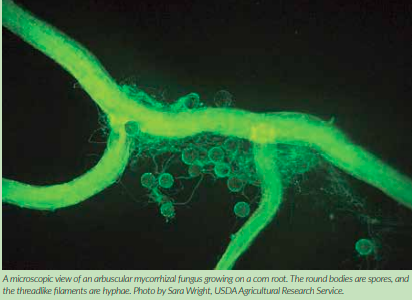
What Farmers Need To Know About Mycorrhizae
Written By Laura Barrera First Published on AGfuse.com
If someone asked you, “How do plants take up the water and nutrients they need?” you’d probably tell
them through the roots. But did you know that for many crops, those roots aren’t working alone?
That’s because most plant species associate with mycorrhizal fungi.What are mycorrhizal fungi? University of Alberta biological scientist JC Cahill says that mycorrhizas are actually the interaction between a fungus and a plant. Although there are many different types of mycorrhizae, the only one crop farmers need to be concerned about is arbuscular mycorrhizal fungi (AMF), as 65% of plant species associate with it.

And barring anything extreme that’s happened to your fields — such as mining or a toxic spill — your soils should already have AMF in it, says Miranda Hart, a soil microbial ecologist at the University of British Columbia. The way AMF works, Cahill explains, is that they grow inside the plant’s roots, and in exchange for sugar from the plant, the hyphae — the threadlike filaments of the fungi — capture water and nutrients in the soil for the plant. While this symbiotic relationship is often seen and discussed as a benefit to crop production, Cahill and Hart warn that’s not always the case. But there are steps farmers can take to help AMF be more of an advantage than a disadvantage for their crops.
Benefits of Mycorrhizae
One of AMF’s benefits to crops, and perhaps the most significant, is phosphorus uptake.
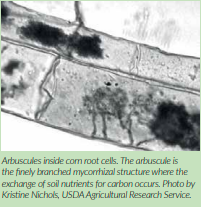
A study at the University of Adelaide in Australia was conducted to quantify the contribution of AMF to phosphorus uptake in wheat. The researchers used phosphorus 32, a radioactive isotope of phosphorus, and grew the wheat in compartmented pots with highly calcareous and phosphorus-fixing soil from a major cereal-growing area in South Australia. Researchers found that over 50% of phosphorus uptake in plants was absorbed via AMF, and phosphorus 32 was only detected in the AMF plants. In fact, an influx of phosphorus in roots colonized by mycorrhizal fungi can be three to five times higher than in non-mycorrhizal roots, according to the article “Phosphorus Uptake by Plants: From Soil to Cell.” The reason for this is because mycorrhizae allows the plant to explore a greater volume of soil.
The book, “Phosphorus in action – Biological processes in soil phosphorus cycling. Soil Biology Vol. 26,” explains that while root hairs can only extend a few millimeters, the hyphae of some AMF can extend many centimeters away. Alice Roy-Bolduc and Mohamed Hijri, authors of the article “The Use of Mycorrhizae to Enhance Phosphorus Uptake: A Way Out The Phosphorus Crisis,” say that in addition to the larger surface area, phosphorus is also highly immobile and phosphate ions become rapidly bound with cations, making it unavailable to plants. However, they say it is known that the presence of mycorrhizal fungi improves phosphate solubility..
Phosphorus uptake is not the only benefit of AMF. Roy-Bolduc and Hijri say that because they extends the root system, they help absorb more water and can access water in smaller pores, thereby increasing plant water uptake. They also improves soil structure, contribute to soil aggregation and decrease erosion. AMF can also help plants resist and overcome pathogen infections, as the authors note that it’s well-documented that mycorrhizal associations protect tomato plants from Phytophthora parasitica and potato plants from Fusarium sambucinum.
Cahill notes that part of the reason mycorrhizae may help with crop protection is because the AMF are already living in the plant. “They’re actually taking up space that other parasitic fungi can’t then take up themselves,” he explains. “So they may actually help protect crop plants from some soil pathogens by filling up the roots.” The combination of all these benefits ultimately can contribute to higher yields and healthier crops.
When Mycorrhizae Becomes Parasitic
While AMF can provide many benefits for plants, Cahill says that in some situations the relationship can be parasitic. An example of this would be if a plant doesn’t need phosphorus or water. The AMF is still present and taking carbon and sugar from the plant, but not giving anything in return. “So what we see in nature is this relationship between the fungus and the plant goes from beneficial to the crop to detrimental, depending on exact conditions at any point in time,” Cahill explains. It’s important to understand this because farmers can help avoid creating situations that would cause the mycorrhizae to become parasitic.
The best way to prevent a parasitic situation is by ensuring the soil isn’t too fertile, Cahill says. Unfortunately, there’s no measurement established that determines the fine line between when a soil is fertile enough for crops, but not so fertile mycorrhizae becomes parasitic. “One of the reasons there isn’t is because it’s so dependent on what species of fungi you have,” he explains. “There are different levels of parasitism, and different crops are going to be differently able to prevent or not prevent parasitism.” Because phosphorus uptake is the No.1 benefit AMF provide plants, Cahill says that if there’s no evidence of phosphorus limitation in your fields, then you might not need to be concerned about mycorrhizae. He adds that mycorrhizae can also change over time — whether it’s from applying an inoculant or introducing a different crop — the effects of which could be positive or negative.
Testing for Mycorrhizae
Unfortunately, at this time it’s difficult for growers to determine whether their AMF is benefitting their crops or not, Cahill says, because it’s not enough to know whether the plants are infected by mycorrhizae. Instead, it’s a question of whether the plant would do better on its own.
Because phosphorus uptake is the No.1 benefit AMF provide plants, Cahill says that if there’s no evidence of phosphorus limitation in your fields, then you might not need to be concerned about mycorrhizae.
“We want to be very skeptical of anybody pulling up a root system and showing you all of this infection because that’s no big deal,” he explains. “We know, typically, the amount of infection in the roots, the quantity of it, isn’t related to the yield of the plant. It’s more complicated than that. It’s the physiological functioning.”

One way to think about it, Cahill explains, is if a plant is infected with mycorrhizae in a positive way, then we can expect the plant to produce fewer roots because the fungi is doing more foraging for it. If you took the fungi away, then the plant would probably produce more roots. But having more or less roots doesn’t guarantee that the plant would produce more or less yield. “You might not actually see a shift in yield because the plants are outsourcing their foraging to the fungus or doing it themselves, but they’re spending a lot of their energy either way,” Cahill explains. If a grower is seeing unhealthy crops or lower yields than expected, then he can determine if it might be an issue with his mycorrhizae by replicating a test Cahill does in his lab. Growers simply take a little soil from their fields, put into a pot of sterile soil and see how the plants in that pot grow compared to plants grown in just sterile soil. “There’s no measure of fungal biomass that we care about,” he adds. “It simply is, put it on your plants and see what happens.”
Best Practices for Healthy Mycorrhizae
Increase Crop Diversity
The best way farmers can help AMF be beneficial for their crops is by increasing their plant diversity.
“The No. 1 way to increase the diversity of fungi, which will also increase the functioning of the fungi, is to increase plant diversity in agroecosystems,” says Hart. Keith Berns, a farmer, agricultural educator and co-owner of Green Cover Seed in Bladen, Neb., recommends having eight to 10 different species in a cover crop mix, with at least six of them being highly mycorrhizal. Aside from brassicas, which do not associate with AMF, Bern says most cover crops are beneficial for AMF. “It doesn’t mean you couldn’t have brassicas in your mix,” he adds. “You just wouldn’t want to have only those in your mix. Buckwheat is also not really highly mycorrhizal.” Almost all legumes, including peas, lentils, vetch, cowpeas, chickpeas and mung beans, are good for mycorrhizal fungi growth, he says. Grasses like sorghums, millets, rye, triticale, barleys — and oats in particular — are also excellent colonizers. He also likes to see flax and sunflowers in the mix, noting they both have excellent mycorrhizal hosting capabilities.
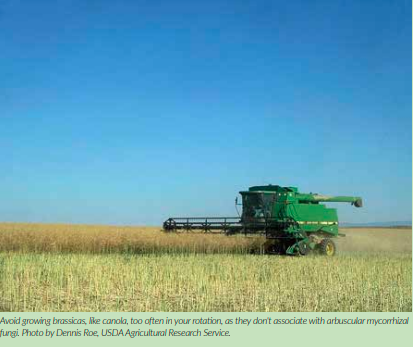
The reason Berns recommends growing so many different species is because it’ll provide a diversity of root exudates. “There may be different strains of mycorrhizae that will like something better than another one,” Berns says. He adds that it also helps ensure there will be something available to feed the mycorrhizae. “If we have weather conditions that are too hot, too cold, too dry, too wet, that may affect some of the species in the mix, but it’s likely not going to affect everything the same amount,” he explains. “It’s not so much the species as much as having the resiliency built into the system to make sure there’s something growing there, because the one thing that we do know is that having fallow ground is literally death to the mycorrhizae, because they have to have a living host.”
Rotate Brassicas and Maintain Weed Control
Because brassicas don’t associate with AMF, Hart recommends farmers who are growing them space them out in their rotation. “In Canada, because prices are good for canola right now, a lot of farmers are going back to mono-cropping,” she says. “But if you mono-crop brassicaceous crops, you’re going to destroy the fungal communities in a couple years completely, because they need carbon. And if they can’t form it with the crop plant, they’ll eventually become extinct in that site.” Hart says that having a brassica in rotation with at least two other crops would be ideal. But for growers who are in a two-crop rotation where one is a brassica, they need to look at ways of getting other plant species in their soil, such as through intercropping or cover crops.
The reason Berns recommends growing so many different species is because it’ll provide a diversity of root exudates.
Brassicas aren’t the only species that don’t associate with AMF. Some weeds, such as lambsquarters and pigweed, are also non-mycorrhizal — another reason why preventing and controlling weed infestations like palmer amaranth is so important. “Whatever plants become dominant in a field, be they crop or weed, we know that changes the composition of the organisms that live in the soil,” Cahill says. “So if you have a plant that doesn’t form mycorrhizae becoming very dominant, those fungi in the soil are likely to become a little bit starved and those populations are likely to go down.”
Reduce Tillage
One practice growers will want to reduce or avoid when trying to promote healthy mycorrhizal fungi and soil biology is tillage. “Tilling is terrible for fungal communities. It destroys the mycelium,” Hart says. “Some fungi can handle it, but some fungi really can’t and they’ll disappear. So you’re going to decrease diversity by tilling.” Cahill agrees, noting that tillage often contributes to soil compaction, which is also detrimental to soil life. “When you have really compacted soil, we know that impacts water penetration and can impose drought, but it also doesn’t give the air spaces and pockets that all these fungi, bacteria and even nematodes and other things need to live,” he explains. “So you need to keep that soil light, which is typically done through no-till.” However, Hart warns that no-tilling often increases a farmer’s herbicide use, which could also negatively impact fungi. But there are some no-tillers like Russell Hedrick andGabe Brown who are successfully no-tilling with fewer herbicide applications by implementing a holistic, systems’ approach.
Be Mindful of Fungicides, Fertilizers
Farmers also need to be mindful of the products they apply if they want to promote AMF growth. “Fungicides will kill fungi, and many of them will kill mycorrhizal fungi,” Cahill says, adding that if you’re concerned that a fungicide may have a negative effect on the soil life, you should test it. This can be done by putting some soil from your field into a couple pots, applying fungicide to one, then growing plants in both and seeing what happens. Growers should also be mindful of fertilizers, Cahill adds, as they often impose some acidity. And as soil pH decreases, it will kill off a lot of fungi and other soil organisms. “Fungi seem to be really sensitive to change in the acidity of soil and salt contents,” he says.
Should You Use Inoculants?
If you’re growing a perennial like alfalfa or a crop that’s going to be there for 10 years, then applying an inoculant may provide a jumpstart for AMF, says Berns. “With a perennial you have no fallow period breaks, so that’s where the mycorrhizae really shine because they never have to jump from one host to another,” he says, adding that it can be harder to justify the cost of an inoculant on an annual crop. But Berns has done some testing with these products on his farm, and has observed some differences between plots treated with inoculants vs. the control plots, particularly with aboveground growth and root mass. This year he put a lot on his corn and soybean acres and is waiting to see if they made any difference.
Cahill encourages all farmers to do as Berns has and become scientists on their own farms, “because they’ll be able to see with their own eyes whether it does or doesn’t have an effect.” He also recommends growers test these products before applying it to their whole fields by again testing them in pots. Farmers can do this by growing some plants in a pot of sterile soil with the inoculant and some in a pot without the inoculant, and seeing if there’s a yield difference.
Growers should also be mindful of fertilizers, Cahill adds, as they often impose some acidity. And as soil pH decreases, it will kill off a lot of fungi and other soil organisms.
The reason he wants growers to do some small trials first is because there’s no widespread evidence these products are beneficial all the time, and if a parasitic inoculant establishes in a field, there’s no easy way to remove it. In fact, he tells his students every year that the one thing he wants them to remember from his class is to not let their moms buy a bag of inoculum from the garden store and just apply it to their gardens. “She’s most likely paying to put parasites on her garden,” he says. “Until you can prove it works in that garden, it’s not worth the money.” He says to think of mycorrhizal inoculants like fertilizer. “We know that adding fertilizer doesn’t always increase crop yield because there are going to be some farms and conditions that have enough fertilizer, or you get toxicity,” he explains. “That’s going to happen with inoculum too.
There are going to be some situations where they’re not beneficial and they might be parasitic, but we don’t know if they are yet.” Hart agrees with Cahill that there’s no guarantee the effect of an inoculant will be beneficial. In fact, she says that the particular isolate being mass commercialized actually depresses phosphorus uptake. “A plant without that fungus is getting more phosphorus than the plant with the fungus,” she explains. “They’re not always mutualistic in every situation. Sometimes, depending on the soil nutrients, the plant and the growth stage, they will actually suppress plant growth and performance.”
But Hart says that in most cases, the inoculant is probably not even establishing. She recalls a 2-year field trial where the commercial inoculant only established in one out of 4 farms. “Where it established, it established quickly and it spread fast,” she says. “But in the other plots, it would’ve been a waste of money for the farmers to use it.” She’s also concerned about the effects these products may have on non-target species, pointing out that there have been studies where this particular fungus has occluded every other fungus in the community. The studies were short-term, Hart says, so it’s too early to make generalizations about it. But she says she can’t in good conscience tell farmers they should be using these products because we don’t know the dangers yet.
Grow Native Species
Instead, Hart recommends growers focus on promoting the mycorrhizal fungi populations already in their fields by trying to grow plants that are native to the land — whether it be through cash crops, intercropping or cover crops — so the mycorrhizal fungi and all of the soil microbes become more diverse, sustainable, and ultimately, more functional. “You want to make it as close as possible to what was original before the land was tilled,” she says. “Because native plants and fungi have evolved together, so they are more likely more beneficial for each other.”
-

Drill Manufacturers In Focus…
CROSSCUTTER MAKES LIGHT WORK OF STALE SEEDBEDS

Preparing the ideal stale seedbed ahead of a direct drill is an exacting task and like many farmers, Richard Budd has tried a number of approaches at Stevens Farm, near Hawkhurst, Kent. With 900ha of combinable crops on land varying from Weald clay to Tunbridge Wells sand, the focus is on winter cereals, but juggling the rotation can mean that volunteers are an issue as well as blackgrass. Volunteers have become a particular problem in winter barley after winter wheat where admix can lead to penalties knocking £15-20/tonne off net margins. “We need to create an effective stale seedbed post-harvest so that we can go in and spray off ahead of a Sumo DTS direct drill,” he explains. “We tried a Sumo Strake, but found it was not moving enough soil. We also looked at other disc systems but we don’t need to work at depth and risk pulling up weeds from below the surface, just to move soil evenly across the working width.” The solution came in the form of a 6.5m Vaderstad Carrier fitted with CrossCutter discs, chosen to work in the farm’s 30m CTF system.

“The CrossCutter disturbs the surface and chits weed seeds to encourage a green flush,” he explains. “It works to just 10mm deep but the two gangs of discs ensure that it moves soil and mixes across the whole surface.” Designed as a high-speed operation, Mr Budd reckons to travel at 16-18kph with the Carrier pulled by a Challenger tracklayer and can cover more than 60ha a day in the right conditions. “It’s a quick, easy operation that also produces a slight tilth to drill into; the packer roll crushes any clods effectively leaving a fine, level surface and we rarely need the levelling boards.” Described as simple to set up and operate, the Carrier is set at its highest working depth and does not dig in.
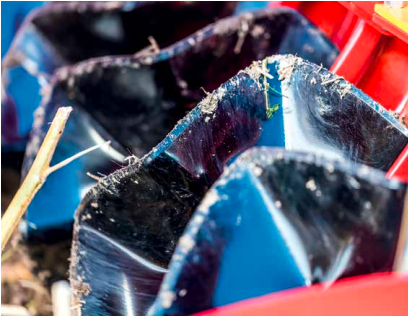
“We use the Challenger for convenience, but when it is tied up with drilling the Carrier can be pulled by our Fendt Vario 724 with no trouble,” says Mr Budd. He comments that the cleaner seedbeds give him more options with rotations, while retaining the benefits of direct drilling. “It might be considered a compromise but we’ve not had to resort to mintill to get the results we want. We had a shallow disc cultivator before but it tended to cultivate in bands, leaving 50% of the working width untilled. There was not enough of a flush with one pass, so we had to go in again, whereas with the Carrier and CrossCutter, it’s one operation and we can close the gate on it until we are ready to spray off for the drill.” He points out that the weed flush also acts as green cover ahead of drilling, avoiding the need to plant a catch crop. A first Vaderstad machine for Stevens Farm, Mr Budd comments that he has been impressed with the durability and build quality of the Carrier. “The discs have covered 1000ha, and would be good for 2000ha more,” he says.
-
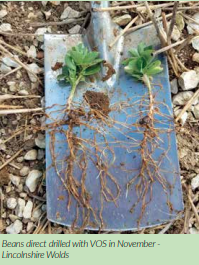
A Quiet Revolution In The Field
Farmers and agronomists in Canada began exploring the benefits of reduced tillage and direct drilling nearly 50 years
ago. The reasons were simple – the need to reduce soil erosion, retain soil moisture, save on fuel costs and reduce
the time taken to establish their crops. It hasn’t been the answer to everything, and in some years additional tillage is
required, but the technique has helped farmers achieve the goal of maximum yield while managing input costs.Here in the UK, direct drilling has become widely adopted lately. One of the drivers has been the emergence of a greater understanding of the need to look after the condition of our soil. The benefits of organic matter and its connection with increased water retention, the improvement in soil structure leading to stronger root growth, more earthworms to break down nutrients and less soil erosion are positive benefits ascribed to no-till. Originating from Canada, the Bourgault VOS system is imported into the UK by Martin Lishman. It is helping farmers to achieve the benefits we have already highlighted. Achieving such results with VOS is the product of many years of Research and Development and listening to farmers’ concerns. There are important considerations in coulter design that should be recognised. As Rick Schemenauer of Bourgault Tillage Tools in Canada says, “Not all openers (coulters) are created equal, so it’s very important that farmers educate themselves on the subject and choose an opener that makes a positive difference to the results.

This is especially true when it comes to ‘one pass seeding’ with high rates of nitrogen fertiliser placed at the same time as the seed. A dual or multi-shoot coulter must be capable of placing fertiliser far enough away from the seed so as not to negatively affect germination or impair the young plant. The VOS 4082 multi-shoot tip has integral outlets with precise horizontal and vertical separation of seed and fertiliser. The furrow is kept open until the fertiliser is delivered precisely and accurately and carbide sealer plates under the tip close the furrow and create a firm seed bed. The shallow angle of the 4” wide wings creates minimal disturbance, a gentle soil flow over the tip and a smooth field finish.
VOS stands for Versatile Opener System, and the range offered certainly delivers on versatility with various options of holders and compatible tips available. Tips come in single or double shoot versions to deliver seed only or seed plus fertiliser; pulses such as beans can be delivered with the same tips or there are specific versions for this purpose. The range also delivers on quality of design and durability. The low disturbance and low draft generated by the tips contributes to low wear rates as well as reduced fuel costs. This is complemented by the high chromium content of the tips and the carbide on the wings which self-sharpens as it wears and provides increased penetration with no soil smearing.
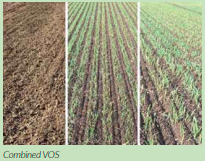
Andrew Harker of H.R.Bourn & Sons, Lincs has been one of the first farmers to adopt the Bourgault system. He shared his experience: “Bourgault VOS has improved the performance of our Horsch drills. Drilling late for blackgrass control, we are seeing less smearing of soil and much less soil disturbance. This is giving us less blackgrass to control in the crop, much improved and more even crop establishment with far better rooting plants.” James Porter of Porters Farms (Walpole) Ltd also gives the system the thumbs up: “The Bourgault VOS coulters have greatly enhanced the performance of our Horsch Sprinter drill. They are extremely versatile; we can use them on min-till land and when direct drilling. We have since benefited from even seed depth and less soil movement, which has greatly helped to reduce moisture loss and resulted in an improved crop establishment.” A quick look at @BourgaultVOS on Twitter will reveal pictures and videos of neatly and consistently drilled crops accompanied by claims of ‘improved drill performance’, ‘better germination’, ‘less blackgrass’ and ‘reduced moisture loss’

An automatic question on the tip of every tongue will be: how many acres or hectares will the tips last for? Of course, there is no simple answer since different soil types will create different wear rates that are difficult to compare. However, a farmer test in Alberta, Canada reached at least 7000 acres. Perhaps a more relevant question relates to min-till as a cost-saving concept. As observed by Adrian Joynt of Goulborn Farms and reported in Farmers Weekly, min-till enabled them to farm a bigger area with less labour and establishment costs reduced to £65/ha.

Growers will all have slightly differing views on what they believe is the right approach to cultivation and drilling, and the majority will get it right most of the time. There is no one answer or blanket statement that will suit all. However, Bourgault VOS has proved to be financially beneficial in saving time, fuel and wear; low soil disturbance has meant reduced weeds such as blackgrass and less chemical application; better moisture retention and improved soil structure has contributed to healthier crops, less soil erosion and reduced water quality concerns; and consistent sowing depth and precise fertiliser placement has helped to achieve increased crop yields and less waste. Users seem more than happy with the results, so it looks like a serious choice for not only Horsch drill users but also users of the tine drills from other manufacturers.
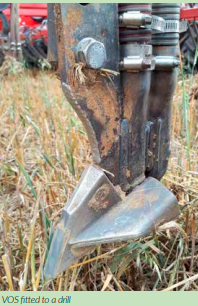
-

Balancing Your Soil
Written by Kristy Wesson of Secanim
KalFos is a slow-release calcium phosphate fertiliser produced from the combustion of animal by-products and
bioliquids. It is produced as part of the UK’s safe and responsible treatment of fallen stock and provides a valuable route for the recycling of nutrients.Replacing costly mineral-based phosphate fertilisers, the majority of which are produced from nonrenewable phosphate rock, the slow-release, acid soluble phosphate contained in KalFos can be beneficial to all cropping systems. Water soluble phosphates are at risk of lock-up or runoff depending on field conditions, and valuable resources can be lost to the aquatic environment, causing pollution of watercourses. The acid-soluble phosphate in KalFos will instead be broken down slowly in the soil, as it is absorbed through acid exudate from roots and their bacterial and fungal associations. This also means that applications can be made to supply multiple cropping year requirements, as the nutrients will be retained in the soil matrix.

In addition to supplying phosphate, KalFos also contains Calcium, Potash, Sulphur and a range of micro-nutrients. The nutrients are truly following a closed loop, as they are concentrated from livestock fed on crops and grass grown in the UK, and are then returned to be utilised for subsequent growing seasons. The product also has a neutralising value of circa 25%, which can be valuable in counteracting the inevitable soil acidification seen with the addition of nitrogen. KalFos is an incredibly cost-effective solution to build up and maintain soil P indices as part of a long-term integrated farming management system. Available in two grades, delivered prices can start from around £50/tonne, depending on tonnage, grade and location. The product is then easily applied using a conventional lime spreader at rates from 1 tonne/ha upwards.
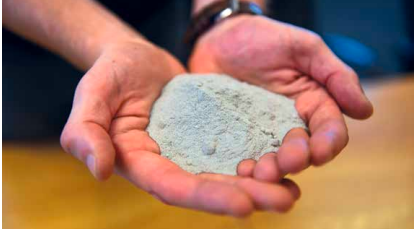
For the best results, the receiving soil should be acidic, and there should be a healthy soil biota population which will maximise the potential uptake of nutrients. The product should ideally not be applied when the soil will be deep ploughed, as the product is best placed in the top 15cm of the soil matrix, in the rooting zone. If min- or zero-till methods are being followed, the product should be applied prior to any surface disturbance, as this will then aid incorporation. Recent trials have shown positive results when KalFos has been applied using variable rates, based on soil sampling results. Soil P indices have been raised across zones, with application rates tailored to zonal sampling results. In some areas, indices have been raised by 2, or up to 183% increase in Olsen-P measurable phosphate. These results show when KalFos is utilised correctly, taking into account soil indices and type, it is a valuable fertiliser for improving soil P supply and minimising potential damage to the surrounding environment.
Secanim Ltd, part of the Saria Group, is pleased to support UK agriculture by producing and supplying KalFos to the farming community.
-

Farmer Focus – Clive Bailye

Staff changes and opting for a bigger drill
Someone once told me that one of the great skills of good management was not being afraid to change your mind. Over the last decade our move to conservation agriculture has created the need to change machinery and labour profiles to match the workload and give us the balanced and efficient fixed cost structure necessary for profitable, subsidy free, combinable crop production. This transition has been gradual. I know when some make fundamental changes to their farming system a farm sale is the first step, often followed by redundancies for staff no longer required. We chose to approach things differently, rapid changes can be expensive, machines sold before their previously budgeted lifespan can look expensive and no one ever wants to have to let good, loyal and skilled staff go. For us the initial transition was simple as our drilling had been done by a contractor for whom in return, we applied inputs and harvested his crops. Ending that agreement and buying a used 750a and a Dale drill to take this work back in house was all that was required. We were fortunate enough to take on an additional contract farm at that time, so no labour had to be let go, the same men were simply able to cope with a greater workload spreading their fixed costs more efficiently.
Over following years changes to the machinery we ran were made gradually, as tractors needed changing their replacements were much more suitable smaller models, that initial 4m second-hand 750a was replaced by a higher output 6m model and the Dale replaced by a much cheaper Horsch C06 conversion. Every change was very carefully considered and only done when a good reason was present. Rising new machinery prices and increasing demand for the equipment we were selling made things relatively painless, the business grew as more contract farming opportunities presented themselves, yet with the much-simplified farming system in place existing labour was able to cope comfortably.
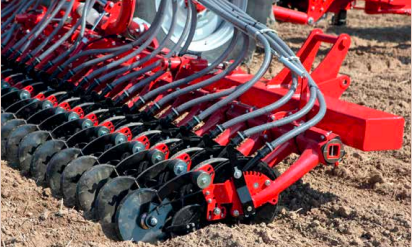
The move away from a self-propelled sprayer to trailed that I wrote about in the last issue of Direct Driller was the final piece of a jigsaw that had taken just over 10 years to complete and I felt we had everything pretty much as efficient as I could get. The wallet was firmly closed, and I felt really rather smug that, come what may through Brexit or changes to farm subs, we were well set up to cope and had nothing but fine details to change over the coming years.
Then, as is so often the case in life, a curved ball gets thrown……. we run a small team of just 3 full time employees; I have always been extremely lucky to employ and work with some exceptional people. I have known two of them since we were in short trousers and was honoured to be best man at both of their weddings. They are not employees, they are some of my closest and best friends. I try to understand their needs, pay them as well as is affordable and involve them in every decision we take. I think as farm jobs go they do alright, we pay a salary well in excess of national farm wages, provide a very nice house for some and are flexible re time off, only really working weekends at harvest and drilling time. The equipment, buildings and facilities are all modem and well maintained and generally we let them manage their own time. It’s a team game, no one works for me, they all work WITH me.
So imagine the surprise when Mark, my friend and longest standing employee of 29 years, who stated working here at 16yrs old came to us one February morning and announced he was leaving. The reason was not pay, hours or unhappiness, he was in fact moving to much lower paid, shift work position in the elderly care industry. His reason was that of work / life balance, a need to know more certainly when he would be at home and ability to plan holidays and days out in the summer when children were off school. Naturally we all questioned his thinking, I honestly feel what we offer is a pretty good package and we are flexible to try and accommodate opportunity and time to do whatever they wish, but ultimately the decision was not mine to make and shortly after this bombshell announcement he left.
Instantly thoughts moved to replacing him, I advertised the position on The Farming Forum and across social media and had a lot of response very quickly. We often hear that there is a shortage of people wanting to work in agriculture, but this certainly didn’t seem to be the case judging by the response I had.
The filtering of CV’s began, most lacked the experience we needed but a few stood out as the kind of people we wanted to work with. Interviewing these applicants it soon became apparent that they were interviewing us, and all of them seemed to view a move to a “small” tractor and trailed sprayer as a backward step from their current positions where it seems a Quadtrac and a quarter million £ self-propelled sprayer is the badge of honour that singles you out amongst your peers as a “top dog” tractor driver. Quickly I realised that a negative attitude towards no-till farming that I had become all too familiar with amongst other farmers was ingrained much deeper within our industry. All that sexy marketing of big flagship kit that has drawn so many farmers into an unsustainable fixed cost Armageddon had clearly also reached deep into the very core of farming, the skilled men on the seats that make it all happen.
No one we spoke to impressed us, in a small team everyone has to “fit” and try as we might we just couldn’t find that person. Hindsight is a wonderful thing, but we should probably have been training up an apprentice, indeed we did try a couple of years ago, but the usual issues of mobile phone addiction and unreliability saw us give up on that idea quite quickly. We needed a plan ‘B’ and with spring work looming we needed that fast.
The question was could we manage without replacing that man? what would the saving be and what would the extra costs be? A week of burying myself deep in spreadsheets and costings began, it was easy to see the £40,000 a year salary saving that employing one less man would bring along with the capital and depreciation costs of a tractor for him to drive, but could we cope with the workload?
The answer was no, it would simply push remaining staff too far to be sustainable and fall apart in a difficult season. Doing less is a bit of an alien concept to us, our aim has always been to grow the business as viable opportunities presented themselves but a detailed analysis of fixed costs structure with one less full-time employee and frontline tractor consistently led me to better numbers with some of our less efficient contracting work dropped. As luck and life often seems to bring, this all coincided rather neatly with a change of business management for one of our contract farming customers, we were simply not comfortable with the changes and lack of commitment from the new management so gut feeling seemed to back-up the numbers on the spreadsheets and the decision was made. Maybe just like in the principles of our farming system less could be more?
The next consideration was the spread of the remaining workload, the labour gap was primarily for a sprayer driver and that created very little overlap to harvest capacity, it was drilling where the potential conflicts lay with still a very significant area to establish in autumn and spring. The existing 6m 750a and Horsch 6m CO with a ULD conversion had given us 12m of drilling capacity and flexibility between disc and tine but with one less highly skilled operator it would be a lot less likely that we could always be in a position to run both at the same time when required.

If any single machine I have ever owned represents the change to our farm over the years it has to be the John Deere 750a. From the first time we established a crop into tall cover it was clear to us all that it was the key component of a very different way of farming. Our first 750a was bought used from Simon Chiles following a visit to his heavy clay farm, I recall my father saying in the car on the way home from Kent that if he could make it work on his heavy clay soils then it should be a doddle for us on boys land …… and he was right, we never looked back, the 4m being replaced with a 6m in 2015. It’s always been the default choice of the low disturbance disc drills for me but being honest that choice was until quite recent years rather limited in the UK. They are not without limitation, our drill being heavily modified and adapted to make results more consistent, and they are also a drill that needs good and regular maintenance from a switched on and committed operator.
When moving from 4m to 6m I looked no further than the 750a, why change a recipe that we knew worked well? Despite there being a lot more choice in the market these days, I suspect that had a wider 750a been available in the UK, then it would certainly have been top of our list of replacements. But alas 6m is thw widest 750A available.
I wanted to move to at least 8m but ideally 12m to fit with our 12/36 controlled traffic farming system and give us more than enough capacity for even the most difficult of seasons, but I really didn’t want to abandon one of the basic principles of my system which was sticking to lighter lower horsepower tractors. Looking around again it became apparent that not many 12m no-till drills existed especially disc coulter versions which I wanted to stick with to compliment the tine option we have with the ULD CO conversion which we will continue to run. Choice narrowed to the Sly Boss drill and the Horsch Avatar.
The Avatar quickly became the stand out choice for me, at the time the 12m Sly was still not a tried and tested formula in the UK but there were already a couple of 12m Avatar users in the UK which I visited. All I spoke to seemed happy with performance and most impressive of all this drill seemed to have an unbelievably low power requirement for its width with just 230hp recommended by Horsch, meaning we could stick to using our existing Fendt 724 tractors that we use for all other arable operations. The coulter is also very similar to the 750a which gives me confidence as we know that it is a design that works for our soil, row width is however much wider at 25cm and is a big reason I guess for the lower power requirement.
The same as the CO and less than a Vaderstad Seed Hawk demo we had many years ago, which to this day still holds the farm wheat yield record meaning I’m not really concerned that it is a negative, it may in fact prove to be a positive with ideas and plans already in place to trial interrow mowed organic spring milling wheat in the future……….. Watch this space! The final deal clinching detail was the price and standard specification, the 12m Avatar comes with 3 hoppers – ISO, seed, and fertiliser placement, guttler style closing wheels and row cleaners from the factory, all things we had to expensively engineer or add ourselves to the 750a’s and all at a price about 25% cheaper per metre as well.
Time will tell of course but it feels like the right decision, we have more capacity, a new drill, one less tractor to fund and one fewer full-time employee to pay. Of course, we also have a slightly lower gross output, but the spreadsheets tell a tale of the savings more than outweighing those losses. So it seems true what I was told years ago, good management is having the ability to change your mind sometimes, no matter how well you feel you might have things set up there is rarely no room for improvement and sometimes things that may initially feel like a step backwards are actually a step forwards.
-

Drill Manufacturers In Focus…
MAKE SOIL HEALTH YOUR NUMBER ONE PRIORITY

The importance of good soil health cannot be overstated, but the key is to achieve it. Strip seeding pioneer Jeff Claydon, who farms in Suffolk and designed the Claydon Opti-Till® System, explains how
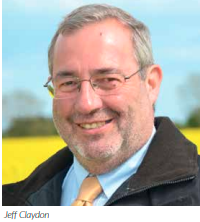
In my last article for Direct Driller I mentioned briefly the importance of good soil health in producing highyielding, profitable crops and here I want to consider the subject in greater detail as it is critical to maximise the benefits of strip seeding. Soil health is a fascinating subject, as many of the 100-plus farmers who attended the Claydon open days at our factory and farm in Suffolk in May found out from leading experts. More from them later. Healthy, well-structured soils with excellent worm populations eliminate many of the risks involved in producing crops. Therefore, soil health must be the Number One priority for UK farming businesses if they are to survive and thrive in an increasingly uncertain global market environment.
The subject is particularly relevant now as many farmers who operate a conventional crop establishment system based on ploughing or deep tillage will be making a loss on every tonne of combinable crops produced at current prices because their costs are too high. These methods can also have an adverse impact on soil health, so to improve it whilst containing costs will require them to change radically how they establish crops. Conventional full cultivations and min-till systems can over-work the soil and destroy its structure, which adversely impacts worm populations and activity. The use of min-till systems and disc-type direct drills can also result in soils which drain poorly and flood easily, creating crops with poor rooting structures and low yield potential.
Degrading the soil in this way also reduces its ability to drain water away during periods of wet weather and increases moisture losses in dry conditions. If, after heavy rainfall, you see dirty water flowing from field drains that means it is full of sediment, so your valuable soils have been degraded by over-cultivation and are literally being flushed down the drain. This sediment will block worm holes and capillaries, starving the crop’s roots of essential air and nutrients, reducing yield potential and ultimately increasing the cost-pertonne of production, as well as creating greater risks from flooding and further soil erosion. With greater public awareness of the countryside and environmental issues such as soil erosion caused by poor agricultural practices farming businesses should review how they operate. A key part of that process is to reduce the agronomic and financial risks involved in producing crops, many of which result from traditional approaches to establishment. But that’s not to say you should go from one extreme to the other.
It is understandable that in the current economic environment farmers want to save costs, but you should not go into no- or reduced-tillage systems without fully understanding the concept and how to apply it successfully. There is no point in saving money on establishment if you don’t get a crop! In my view a completely notill approach cannot produce the consistent, reliable results and high yields which we have achieved with the Opti-Till System of strip seeding during the last 16 years, particularly on heavier soils. Using no-till alone also poses significant risk as you are much more at the mercy of wet seasons or dry seasons and may struggle to get seed in the ground or achieve sustainable yields, while corrective subsoiling may be required if the soil slumps. However, in some seasons a mix could work well, if you are able to justify the use of two drills.
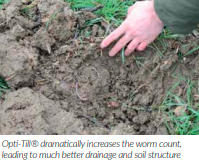
A Holistic Approach
Claydon pioneered strip seeding and has perfected the Opti-Till® System, a holistic approach to crop establishment which delivers consistently high yields at low cost, thereby maximising profitability. Providing that the soil is drained, is reasonably sound, work is done when conditions are suitable, and you have a good rotation to help control weeds then this technique is suitable for every farm.
There are huge benefits from using Opti-Till® correctly. Soil health and structure are greatly improved, soil drains more freely in wet weather and retains moisture in dry conditions, while earthworm numbers are dramatically higher. This is critical, because healthy, well-structured soils with excellent worm populations eliminate many of the risks involved in producing crops. Rooting structures are much stronger, resulting in better crops that utilise inputs more effectively and more efficiently whilst being more resistant to drought, while yields increase and ‘per-tonne’ production costs are much lower.
The start of the process is to use the Claydon Straw Harrow to produce a shallow micro tilth up to 30mm deep, which destroys slugs and slug eggs and encourages volunteers and weeds to chit, enabling them to be controlled more effectively, at lower cost and with less reliance on chemicals. This micro tilth is usually more than adequate to cover the seed, create a warm, humid environment around it and promote rapid crop establishment. If slightly more tilth is required it can be created with a Claydon TerraStar light rotary cultivator.

The key to Opti-Till® is the Hybrid drill’s patented, leading tine, which has a breakout force of 600kg, more than twice that of many other direct drills, so it remains stable and works at an even depth. Adjustable from 0mm to up to 150mm deep for establishing deeprooting crops like oilseed rape, it lifts and aerates the soil, creating fissures, alleviating localised compaction, improving drainage and providing space for strong rooting structures to develop. The leading tine is followed by a separate seeding tine which places seed within a band in soil which has just been lifted and loosened. Using press wheels on the drill or rolling separately immediately after drilling, particularly on heavy soils which are wet, pushes the air out of the soil and can cause the particles to stick together. Therefore, we recommend letting the soil ‘haze over’ for 24-48 hours after drilling and then rolling or harrowing. This approach delivers perfect results.
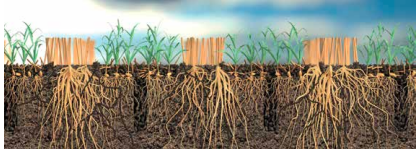
The Opti-Till System does just enough to make direct drilling work without the need to subsoil, as with a lowdisturbance drill system, or having to correct damage from the sedimentation of over-worked soils where min-till or plough-based establishment is used. Doing just enough cultivation at the point of drilling retains the soil structure, provides the crop with the ideal growing environment and gives it the strongest possible start. This allows the soil to start improving and the sooner this process begins the more quickly it will do so. Targeting cultivations in this way ensures that soil density is retained over at least 50% of the field, which supports following field traffic throughout the season and keeps tramline depths to a minimum. Fields are left level due to the design of the Claydon Hybrid drill, soil structure and seedbeds are consistent over large areas, so crops develop and grow evenly. That makes it much easier to apply fertilisers and agrochemicals at the optimum time.
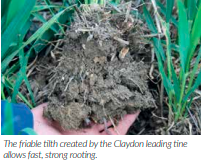
Drilling seed in bands provides an ideal environment for worms to thrive. This is essential because their action benefits soil health in so many ways. Because most worm burrows and capillaries are left undisturbed worm numbers are safeguarded, which aids drainage and water movement through the soil profile throughout the growing season. Plant roots are also left largely undisturbed which adds to the soil biota and improves soil structure, organic matter depletion is minimised due to nominal soil disturbance, while soil moisture and nitrogen are preserved.
The friable tilth created by the Claydon leading tine allows fast, strong rooting. Emergence is rapid and unhindered due to the excellent soil structure, while the soil can also absorb heavy rainfall without capping. Because the seed is sown in bands crops utilise more of the growing area, maximising moisture and nutrient takeup. The fact that seed is spread across the working area of the seeding share allows more air and light into the crop, which improves photosynthesis as the plant grows.
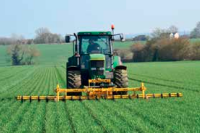
A further benefit of strip seeding is that drilling into stubbles helps to keep snow in place and settled on the seeded area, which acts like an insulating blanket for the crop in very cold weather. As the temperature rises, snow thaws and melt water drains through the soil profile. This area also warms more quickly due to the darker colour of the soil. The other advantage of strip seeding at 30cm centres is that the 14-15cmwide unseeded strip between the rows can be mechanically hoed. The Claydon TerraBlade inter-row hoe is a low-cost, mechanical method of controlling weeds in combinable, bandsown crops.
It provides an additional weapon in the agricultural industry’s weed control armoury at a time when the efficacy of some herbicides is decreasing whilst the cost of control is increasing. The TerraBlade eliminates weeds from that area reliably, safely and without using chemicals. This clears up any weeds that were missed by the ag-chems, or where such products cannot be used, greatly reducing the return of weed seeds, the overall weed burden, the potential for carry-over of weeds seeds and the risk of more resistant types developing. By keeping the unseeded rows clear of weeds during the early stages of crop growth, competition for nutrients, light, air and water is reduced and the young plants grow away strong and healthy.
When soil is biologically healthy and you have created a high worm population with a high level of worm activity, many soil-related issues, as well as many of the risks involved in producing crops, diminish greatly. In the 16 years of using the Opti-Till® System on the Claydon farms we have seen much lower levels of plant disease than on farms which still plough due to the much higher levels of soil biological activity. Instead of continuing the cycle of poor soil structure caused by conventional methods of crop establishment it makes sense to re-evaluate what is required going forward. Innovative equipment such as the Claydon Opti-Till® System greatly improves timeliness, reduces establishment costs by up to 80%, creates correctly structured, supportive soils, encourages high worm populations, promotes biodiversity and ensures excellent drainage. This results in sustainable, high yields, greater resilience to extreme weather, numerous environmental benefits and improved profitability.
But you should not expect simply to buy this type of equipment and expect instant results. It is important to understand how to get the best from this new approach, correct any deficiencies in soil nutrition and introduce an effective programme of stubble management between harvest and drilling. We invited Dick Neale, Technical Manager of Hutchinsons Crop Protection, to the Claydon open days to explain more about the importance of soils and how to achieve good structure. Visitors found what he had to say fascinating.
Transitioning To Strip Seeding
“Transitioning from conventional crop establishment methods to strip seeding is not difficult, but there is a process to go through to achieve optimum results,” Dick stated. “It’s very easy to get right, but also very, very easy to get wrong, so understand what needs to be done, appreciate that it takes time, be patient and do not expect instant results. “Many fields are over-cultivated and consequently farmers often say that their soil does not work like it used to, do what it used to or produce crops like it used to. Much of this is down to the fact that in a plough-based system there are 80 per cent less earthworms, so it will take two to three years to build their numbers sufficiently to completely break down surface residues and for the soil and ecology to adapt to a strip seeding system. When changing to the Claydon System you should therefore ensure that your stubble is very well managed or grow a catch/cover crop.”
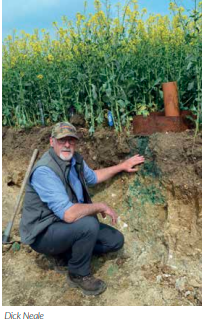
Emphasising the critical importance of having a healthy earthworm population, Dick stressed the need to know the main types and how they operate:
• Epigeic: Spend most of their life above ground and survive by processing decaying/dead organic matter.
• Anecic: Tend to make vertical tunnels and their primary food source is decaying matter on the soil surface, such as stubbles. Can often be identified by characteristic soil ‘middens’ surrounding the tunnel entrance.
• Endogeic: Create sprawling burrows underground, only come to the surface when excess rain puts them at risk of drowning and live on organic matter beneath and mixed into the soil. They are key to optimising the soil’s structure, drainage capability and ability to store water and nutrients, but are very sensitive to cultivations.
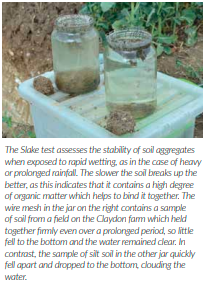
“Worms burrow up to 2m deep, way beyond the scope of any mole drainer or subsoiler tine and are fundamental to efficiently draining and oxygenating the soil,” he added. “As they move throughout the profile they act as pumps, pushing oxygen around the network of borrows, but to do so must have access to surface straw to provide food. If we can achieve 30 deep-working earthworms per square metre things really start to happen in terms of benefits to the soil.”
Give Your Soils A Helping Hand
Another guest speaker at the Claydon open days, Dr Elizabeth Stockdale, Head of Farming Systems Research at NIAB, said that every farmer should ask themselves ‘How can I help the soil life help me?’ Soil is a very complex web of interactions, but if it is in the right condition, with the right structure and nutrition in place it will deliver the results you are looking for. The key is to appreciate that its natural biology is there waiting to help; you just need to create the conditions to allow it to kick in. She added:
“The physical, biological and chemical properties of the soil must all be right for it to deliver optimum performance. Address the soil’s physical component by knowing your textures, understand its limits in terms of workability and trafficability, optimise water balance through drainage if necessary, improve soil structure and minimise compaction to achieve effective, continuous pore space. Optimise the soil’s biology by feeding it regularly through plants and organic matter inputs, moving it only when necessary and diversifying plants in space and time. To address the chemical side, maintain optimum pH, provide the right amount of plant nutrients, in the right place, at the right time, and know your soil textures, as their buffering capacity provides a free supply of minerals.
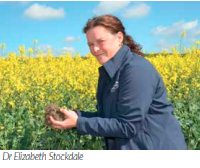
“All land is unique and often one field can contain several different types of soil, which set the inherent limits to its physical properties, while management modifies those properties. Soil structure is broken, not made, by machinery: the plant roots, earthworms and glues/ gums created by the decomposition process are the keys to the soil’s structure and aggregating ability. Food diversity is essential for both human and soil health, so adding more food to the land will allow it to support more biodiversity. Therefore, move soil only when necessary, avoid leaving ground bare and ensure that crops are grown in optimum conditions so they can maximise photosynthesis. “Working effectively with the soil requires an integrated, flexible approach to soil husbandry. Changing one aspect of a system can change the entire outcome and so, for example, the same drill might work differently in different situations and soils. When changing to strip seeding you cannot simply buy a new drill and expect that everything will be fine: you must adapt your system and tailor your husbandry accordingly.”
FINAL THOUGHTS
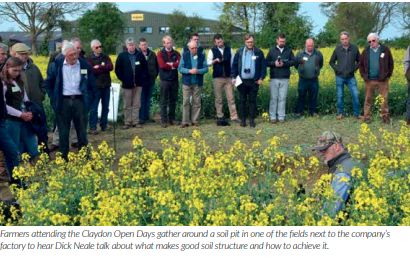
The cost of the Claydon Opti-Till System is much lower even than with min-till and dramatically less than a plough-based system. Instead of using 150-180 litres of fuel/ha to establish a crop using a ploughbased system, with Opti-Till we use 10-15 litres/ha (average 12l/ha), which includes stubble management and drilling. The enormous savings that we make allow us to invest more in other inputs and areas of the farm that really make a difference. The cost of wearing metal is very low, at just £3-£4/ha. As the soil becomes healthier and in better condition the amount of power required to work it and cost of wearing metal continues to decline. Power requirement is just 50hp per metre for Claydon Hybrid drills, so output is much higher and fuel use is dramatically lower.
On the Claydon farms we use a 300hp tractor to pull our 6m Claydon Hybrid drill and because of the very high work-rate the tractor clocks up less than 100 hours per year to establish our 350ha of crops. With everything in the ground in good time we have time to do another 1250ha of contract drilling, creating additional revenue. It is not our experience to see a yield decrease where soil is in reasonable condition when you start with the Claydon System. We have seen an average 10% increase in yields on Claydon-drilled farms, as have customers who start with soils which are in reasonable condition, free of compaction, drainage or weed issues.

To learn more about the ClaydonOpti-Till® System
scan the code. -
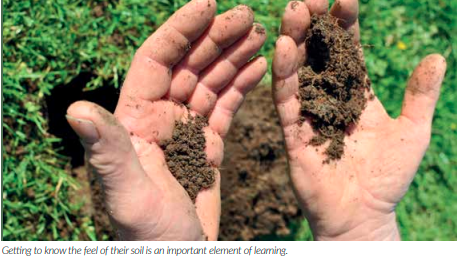
What Is It Like To Do Sustainable Soil Management? The English Farmers’ Experience
Dr. Anna Krzywosznska is a social scientist, and a Research Fellow at the Department of Geography at the University of
Sheffield. Over the last few years she has been studying the uptake of sustainable soil management practices amongst
English farmers. She has found that the experience of adapting soil-friendly farming systems can be difficult for
farmers because it makes them ‘stand out’ from their peer community. As a result, these farmers create ‘communities
of practice’ in which they can both exchange learning and support one another. She has also found that these
communities are reaching out to scientists who become not only sources of information, but also sources validation for
these new ways of being a good farmerGlobally, soil degradation is one of the biggest challenges to food security and environmental sustainability. According to the Food and Agriculture Organisation of the United Nations, a third of global soils are now degraded. In the United Kingdom, the concerns are also growing that soils are losing their functionality, and will not be able to support agriculture and the wider environment in the future. While everyone has a role to play in preventing soil degradation, farmers and land managers certainly have very good reasons to protect their soils. However, achieving this in practice is not as straight-forward as we would like it to be.
That is because practicing sustainable soil management in many ways goes against mainstream farming practice. Modern farming has developed primarily through a focus on ‘tractors and chemicals’ – better, bigger, faster machinery, and stronger, more effective chemical solutions to both fertility and pest problems. As a result, soils have started to be seen by many farmers not as a resource, but as an obstacle, and a lot of effort is channelled every year into overcoming soil limitations to achieve the best possible yield. Furthermore, mechanical and chemical technology has been so successful in producing high yields that most farmers have started using a very similar ‘toolkit’ to manage their farms. As a result, there has been less local adaptation and innovation, and more reliance on advice from agronomists and input producers.
Sustainable soil management methods are rather different. In contrast to conventional farming, sustainable soil management does not have ‘a blueprint’, which means that local adaptation of general rules is necessary. This is very typical of sustainable farming practices, and it makes them more knowledgeintensive. So how do farmers learn how to shift their farm to a sustainable soil management system? And what is the role for scientists and researchers in supporting the spread of sustainable soil management? Read on…
How do farmers learn?
It is important to remember that taking up innovation such as a new farming system is not just an individual process: humans typically learn in groups. People who are interested in a particular activity which requires a lot of knowledge tend to form ‘communities of practice’. Communities of practice are simply groups of individuals who share certain practices and who seek to learn from one another to become better at what they do. Dog owners, cooks, musicians, gardeners, parents – they all form communities of practice, which can be more of less structured. We all belong to many communities of practice simultaneously in our lives.

In communities of practice we not only learn from one another how to do a certain activity, but also decide and negotiate what is the ‘right’ way to do this activity. Doing things ‘the right way’ means being a good member of a community of practice – a good dog owner, cook, musician, gardener, or parent. Or even – you guessed it – a good farmer. Members in communities of practice are constantly discussing what the right things to do are, and therefore what it means to be a good community member. Sometimes some individuals may have ideas that are so radically different from the majority that they split off and they form their own community of practice (think, for example, of how ‘jazz’ used to be seen as noise and had to form its own community to become recognised as a form of music). And this is what is happening with farmers practicing sustainable soil management right now.
So what is it like for an individual farmer to ‘split off’ the mainstream farming community, and try out a sustainable soil management system? My research suggests that there are three stages to this process: seeking, experimenting, and contributing. I have also seen that as the farmers change their system, they use scientists and scientific sources of information in various ways.
A different way of farming is possible
The seeking stage starts simply with the realisation that a different way of working the soil (for example not ploughing) is possible, that it exists. Farmers I interviewed told me that they first became interested in looking for a different way of managing their soils because of concerns about inefficiency, such as the amount of time and fuel spent on establishing seed beds, or a desire to increase productivity, such as enhancing sub-optimal yields or maximising micronutrients in crops. None of the farmers I interviewed told me that they had been initially motivated by environmental or soil conservation. Once they became aware that changing soil management was a potential way to address these productivity or efficiency related issues, the farmers looked for information about this from other farmers as well as from scientific reports.
Interestingly, the farmers I interviewed told me that being exposed to this new information was not just a process of learning. They often spoke of something we could call ‘a lightbulb moment’. Very often, this inspiration was related to a change in perspective on their soils, from seeing soils as an inert substrate to seeing them as a living system. Farmers described this as a change in perspective or mentality, an inspiration, or even ‘a farming life-changer’. One farmer told me;
‘I’d always thought the organic matter was better off being mixed into the full soil profile. …at that meeting I learned that the organic matter and most of the life of the soil was in the top sort of two inches of the soil. … So that was a sort of, I wouldn’t say an epiphany, but it was a change of mind-set from that meeting onwards’
For some farmers, particular individuals, such as Elaine Ingham, or Elizabeth Stockdale, were particularly inspirational at this stage. After spending some time in the ‘seeking’ stage, the farmers would move on to experimenting. For some farmers, starting the experimentation meant ‘biting the bullet’ and, for example, investing full-scale into direct drilling machinery. Others did things more gradually, for example adopting only some of the elements of the system, or using contractors to try out new practices on a particular site.
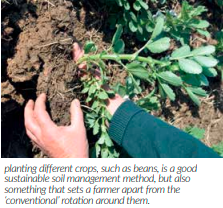
Starting experimentation immediately set these farmers apart from their farming neighbours. A change in practice was easily visible to the neighbours through for example ‘scruffy’ looking fields. The farmers working in the new system would also have different working rhythms (because for example they no longer ploughed), which meant they were not always in the fields at the same time as their neighbours. Their crops could also have different germination and growth rhythms. As a result, the farmers I interviewed were very aware that their fields were essentially telling anyone who know how to look that they were doing something ‘unusual’ – perhaps even ‘abnormal’. As a result, many of these farmers felt themselves branded as ‘mad’ by their neighbours. This could create very real feelings of isolation and even loneliness, especially for those farmers in the early stages who were not yet seeing any benefits from their new methods. One farmer told me that
‘sometimes it does feel very lonely when you see your bad fields and the neighbours good fields’. Another farmer how being ‘different’ was stressful as it was putting his reputation on the line, and even endangering his contracting business:
‘It would be nice to see other people practicing it in the area, and seeing how they get on because, you know I’m sort of sticking my neck out doing what I’m doing …I don’t particularly want to be pushing the boundaries too far really to the extent that, yes I end up getting either egg on my face or losing money … or credibility.
Dealing with being ‘different’
Participating in face-to-face and online groups of ‘like-minded’ farmers helped the farmers feel less alone in the risky process of making changes to their farm. Online activity was very important, and the farmers I interviewed used online fora (such as the Farming Forum), and connected to through Twitter or WhatsApp groups. This allowed them also to connect internationally, particularly with farmers in Australia, New Zealand, and the US who also speak English but who have a longer experience of soil conservation methods. The farmers I interviewed stressed that this increased interaction was crucial to them in taking their first step into sustainable soil management, and to maintaining their practice in a largely unsupportive environment. As one farmer told me, in relation to his and a friend’s participation in their local group:
‘I wouldn’t be able to do this on my own. I think (my friend) has struggled being out there on his own, and farming effectively on his own, because he makes huge leaps in his management, and then falls back because everyone around him is conventional, and that farming community effectively isolates him. And he thinks oh, I might just do it the old-fashioned way.’
This particular farmer told me that interacting with other members of the community of practice helped him retain a sense that sustainable soil management practices are meaningful and not a waste of time and effort. A sense of community was seen as very important in remaining committed to what some may see as a difficult and unnecessary process. A more experienced farmer also commented that:
‘just being able to talk about what we’re doing with likeminded farmers, I’d never have gotten as far, or even dared to do what I’ve done without knowing that other people are out there with the same ideas and doing the same sort of thing.
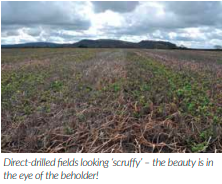
What was the role of science?
Most experienced farmers were at the contributing stage, spreading the knowledge and information about sustainable soil management. While all the farmers interviewed used scientific hypotheses to justify taking up sustainable soil management methods, they did not usually use scientific tools and procedures to monitor outcomes systematically and validate these hypotheses in their own fields. For example, a number of the farmers commented on the expected benefits soil conservation would have on the biological activity in their soils, but few sought to verify this through soil testing or systematic earthworm counts. Similarly a number of farmers argued that soil conservation would increase soil organic matter, which would in turn result in higher nutrient density in their crops; however, they did not seek to validate this through, for example, systematic tissue analysis. In fact a number of the farmers interviewed expressed belief that the new system was ‘the right thing to do’ even when they were unable to indicate specific positive effects for their farm business. As one farmer explained:
“What makes me do it, comes back to intuition, I just think for all sorts of reasons and all the things I’ve picked up in the last few years doing it, I think this is right, the right thing to do …in my mind it’s the right thing to do.”
The farm is a complex and openended system, and some of the farmers interviewed pointed out that trying to validate cause-effect relationships in this context may not be practical for them. Interestingly, however, the support for sustainable soil management in the scientific community was important to this community of practice. The support of scientific institutions and individual scientists was especially important as many of the expected effects of conservation agriculture either take a long time to become apparent (e.g. increases in soil organic matter), or are impossible or impractical for farmers to validate in the context of individual farms (e.g. positive impacts on watershed hydrology or carbon capture). While not being able to point to scientifically verifiable outcomes, the farmers referred to scientific studies about the overall positive impacts of conservation agriculture on soil processes. This allowed them to add legitimacy to what other farmers may be seeing as ‘abnormal’ practice.
So what role did the sustainable soil management farmers see for scientists and scientific research? The farmers I interviewed wanted for scientists to become more involved in their on-farm experimentation. The farmers called on scientists and researchers to help them clarify the usefulness of new technologies and techniques in achieving the objectives the farmers had in mind. The farmers interviewed also wished scientists would get more involved in demonstrating the value and validity of sustainable soil management to other land managers and to society more broadly. Science, these farmers felt, was important to convince others – even though, in practice, they themselves had only been convinced by ‘seeing with their own eyes’ and experimenting in their own fields. As one farmer said:
“[the proof of the positive changes I’ve seen] it’s quite physical and quite observational rather than lab, you know, putting numbers on it, and again I know that for some people that’s a problem, I’ve had even the farmers, when they visited you, tell them how much better it’s [the soil] got and they’re like yeah but you can’t prove any of that and they’re dead right, I can’t.”
A farmer-led change in which scientists are welcome
My research showed that the leadership on sustainable soil management as a different form of farming is coming from the farming community of practice. As far as the farmers are concerned, the role for the scientists is to work with this community and help them grow and become better, enhancing their learning and supporting their authority. Working together, they suggested, with the farmers identifying research needs, would both generate valuable learning by validating the hypothesis the farmers have, and create scientifically valid evidence in support of sustainable soil management methods. These farmers placed their own values and mission at the centre, and saw themselves as well placed to generate the research questions and identify areas for work to be performed by the scientists:
“It’s very important that the scientific community are chipping away …backing up all these what are effectively anecdotal reports – that’s the important thing the scientific community and academic community are doing; is looking at all our weird farmer anecdotes and then methodically and studiously showing why those anecdotes are the case.”
There is a great appetite in the sustainable soil management community for interacting with scientists. To be effective, this collaboration should be structured in ways that the farmers see as useful and relevant. The scientists are very welcome, but the farmers are the ones at the wheel.
This article is a shortened and modified version of the paper “Making knowledge and meaning in communities of practice: What role may science play? The case of sustainable soil management in England.” Published in Soil Use and Management, 2019; 35: 160– 168. You can access the full version of this publication by scanning this code

Dr. Krzywoszynska is also the founder of the Soil Care Network, which has a fantastic monthly newsletter on all things soil. You can sign up on the Soil Care Networks website . If you have thoughts about this article (were your experiences similar, or different?), why not tweet to Dr. Krzywoszynska on @Anna_K_speaking. You can find more information on Dr. Krzywoszynska’s research and her publications by scanning this code

-
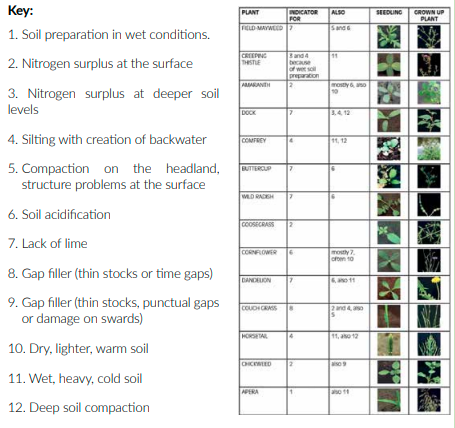
Analysis Of Indicator Weeds And Organic Crop Rotations
PH-value, soil structure (elimination of capillary action, compression, smearing of the soil) and moisture of the soil can
be seen by the growth of different weeds. If the crops in the field show an irregular growth pattern or there is extremely wet harvest and poor soil preparation conditions resulting in silting, acidification, nutrient or oxygen deficiency this will be visible for years in plant growth. Moreover, a lack of nutrients will make weeds discoloured to the human eye. The following graph examines results for having certain weeds.
Crop Rotation
It is important to understand the correlation of crop rotations. Single crops should be selected because of their cultivation and soil advantages instead of an economical advantage. The crop rotation should be designed that the available nitrogen will be used by the selected crop. The crop rotation links should be designed like this: Nitrogen collection – Strong consumption of Nitrogen – Low Consumption of Nitrogen Slight overproduction of nitrogen is important to increase the humus content in the soil. (to increase the humus content by 1 %, 1200 kg/ha nitrogen is necessary)
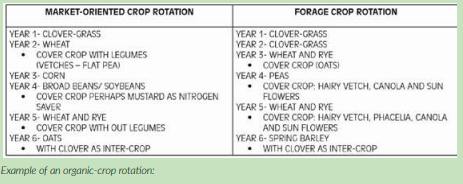
Principles of good crop rotation: (Year 1)
• percentage of legumes should be between 20 – 25 %
• percentage of grain should be a maximum 50 – 60 %
• percentage of root crops should be a maximum 5 – 25 %
• Alternate between
• plants with deep roots and shallow roots
• nitrogen collecting – consuming
• winter crops – summer crops
• root crops – grain crops
• cover crops and intercrops
Goals of a balanced crop rotation:
• Preservation of soil fertility
• Maximizing nitrogen collection
• Weed control for example.: clovergrass: regulation of thistle
• prevention against disease and defence against pests
• mobilization of nutrients
• plants covering the soil throughout the year (cover crops)
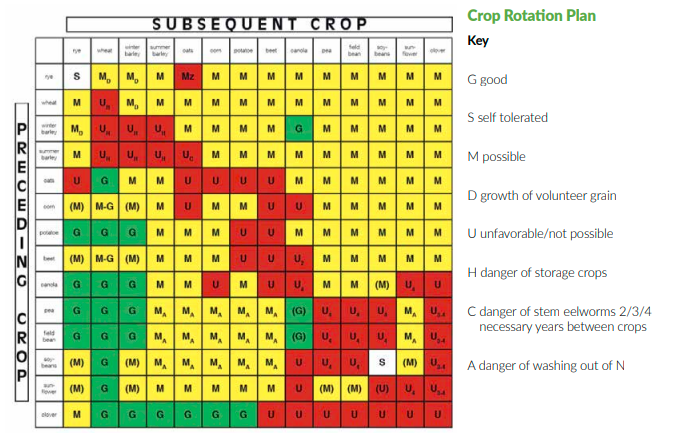
-

Water Focus Affinity Water Sponsor Feature Groundswell 2019
At this year’s Groundswell, headline sponsor and the UK’s largest water-only supply
company, Affinity Water will demonstrate the relationship between soil health, water
resources and the environment.
Shaun Dowman, agricultural advisor at Affinity Water, explains that there is a need to change how we manage our soils and water resources, and that a close relationship between farmers and water companies is the key to achieving this. “Whether you farm on the banks of the Thames or the tops of the Downs, every piece of land, every farm in this country sits within a water catchment,” he says. “Therefore, what happens on farms and in the field is of interest to the water industry and we want to help farmers make choices for their farm business, that will positively impact water and the environment. “Conservation agriculture offers the chance to restore degraded soils, tackle climate change, protect water, feed the world and enhance biodiversity. This is why all of us at Affinity Water are excited by Groundswell and, are once again proud to be headline sponsors of this hugely enjoyable, thought-provoking and positive event,” says Shaun.

A ‘healthy soils = healthy water’ ethos is at the heart of the Affinity Water business and is expertly demonstrated in the relationship between their head of water quality, Fiona Waller, and her no-till farmer husband, Ian. The couple farm 450ha of mainly arable land in the mid-Chiltern area, and have worked together to help improve water quality both on and off the farm. Direct Driller talked to Fiona and Ian on how their job roles impact their agricultural and water management decisions.
What would you say is the most important piece of kit on your farm?
Ian: The most important tool is a garden fork for getting a good look at my soil. We have a high stone content in our soil which can impact the accuracy of measuring compaction with a spade or penetrometer. The prongs of the garden fork find their way past the stones giving a much more accurate picture. If the soil falls through the prongs of the fork, that’s always a good sign. I usually check my soil health in the autumn, winter and after harvest. I always try to take the fork with me when I go for a walk to test an area that is looking particularly good or bad.
Fiona: From a water quality perspective my focus would be on the farmer themselves. They have the knowledge, they know where their land boundaries are, where the water flows, where it floods and what happens on their land when it rains. Essentially, hearts and minds are as important as any kit. Fiona, how does being married to a farmer influence your work at Affinity Water? I work very closely with our catchment team, so it’s been really helpful to be able to share ideas and information from Ian with them. Affinity Water has been doing catchment management work for the last eight years and during that period we’ve had really close links between the catchment team and farmers. But in the beginning, I used Ian as our main sounding board and the catchment team came to the farm for a visit, to learn more about some of the challenges and to see for themselves what could be achieved. This relationship helps fill the gap between water industry and agricultural knowledge. For example, when we were discussing the impact metaldehyde was having on water quality, I was able to discuss this with Ian to get his input. I was also able to provide the team with information on ferric phosphate, as Ian had been using it with great results for many years.
Ian, how does being married to Fiona impact your farming practices and decisions?
I’m very aware of the impact that agriculture has on water quality, and this is all coming home to roost now that it’s very high up on the government’s agenda. The ‘eye opener’ for me is seeing what Fiona goes through when there are problems with water pollution, and how seriously this impacts the water industry. Most farmers aren’t aware of all the work that goes into providing high quality water and all of the measures in place to achieve this. I’ve been to a surface water treatment works three times now and it’s so enlightening to see what goes on. I find it staggering how much sediment, which is essentially topsoil, comes out of the works. We’re talking about lorry loads every day from just one treatment works.
Farmers need to do something about this and I’m a firm believer that direct drilling has a big part to play. However, it’s also about doing a whole host of things right to stop this, and for those of us who are aware, to share knowledge and educate. Ian, what three conservation practices would you recommend to other farmers to protect their soils? Growing cover crops is extremely important, but finding detailed information can be hard. I’m constantly striving to find plants that I can grow in a short space of time and understand how to grow them, so cover crops are at the top of the list of things that I want to learn more about.
Secondly, treat every day as a learning day. Don’t think you know it because it’s happened once, you need to keep improving your knowledge. People always ask me what my goal is, and I say to improve soil health, but it’s a long term goal. We have damaged some soils over the last 50 years and so it could take as long to rebuild their condition – I’ll never achieve it, it’s an ongoing project. Finally, we need to do more research on soil. I have a saying: ‘Soil is like the ocean’ – we know about the big things in the soil; the equivalent of whales are worms, but we don’t know enough about all the smaller bacteria and microorganisms and their interactions with our farming.
Fiona, what are your top tips for famers who want to have a positive impact on water quality?
The best thing that any farmer can do is to engage with their local water company catchment team. These teams are full of really enthusiastic people who want to work with farmers to improve water quality. They will have access to some funding through schemes and grants that companies, or Natural England may have and can help you to identify these. Finally, soil health is the key to improving water retention on land, to prevent flooding and to reduce the amount of soil, pesticides, and nitrates running off into watercourses. Farmers need to focus on soil health as much as yield and crop output.
By doing this yields could increase at the same time as water quality being improved. Ian, you’ll be attending Groundswell this year, what are you most looking forward to seeing at the event? I’m really looking forward to attending both days of Groundswell and in particular I’m looking forward to attending the lectures on rebuilding soils. I’m especially interested in the interview with Sue Pritchard, Henry Dimbleby and Rosie Boycott, on ‘Does Britain Need a Food Policy?’, as I think this will generate a good debate. The event is also a great opportunity for me to meet like-minded individuals to share experiences and develop new networks within the zero-till community.
Farm profile:
• 450 ha split into six blocks
• Predominantly milling variety winter wheat – for Warburtons
• Other crops: WOSR, spring beans, cover and fodder crops
• 65 breeding Herdwick ewes – used to manage the grassland, cover and fodder crops
• 18% of farm is in stewardship
• Predominantly medium loam soil type
• Zero tillage across the whole farm as of last year
Affinity Water at Groundswell
• Stand FY1: Affinity Water Catchment Hub
• Cover crop panel discussion – 10:15am on 26 June in conference barn
• ‘Low cost, open-data and DIY approaches to assessing the public goods provided by your land’ – 3:15pm 27 June in the conference barn, Sophia Burke and Mark Mulligan
• Rainfall simulator with Jay Fuhrer – at the Affinity Water Catchment Hub
• Catchment augmented reality experience – at the Affinity Water Catchment Hub
• Water station with free souvenir Groundswell re-usable water bottles
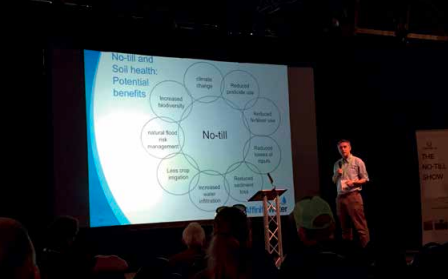
-

Drill Manufacturers In Focus…
NOVAG SET FOOT ON ENGLISH GROUND

“At the beginning of our story, we started working with Baker No-Tillage Ltd, a manufacturer from New Zealand, to source openers for the first machines we designed”, says Ramzi FRIKHA, export manager and company founder. This partnership did not work, due to strong disagreements about improvements to be made to the technology and general business terms. But the early Novag team followed its vision and developed their own opener, with agronomical advantages and efficiency in mind. This is how Novag was born. First farmers from France put their trust in the young company and in their drills, and then, Novag began exporting across Europe, Russia, and even Canada. Our modern no-tillage seed drills, designed and produced in our new factory at Fressines, ensure greater yields and reduced costs.
Awakening the microbes
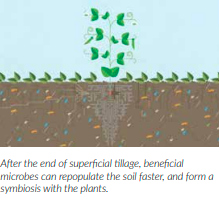
We believe that key for outstanding yields is right under our feet: healthy soils. To get to that point, our Novag system aims to end soil disturbance and superficial soil preparation for good, stimulate and protect soil life, and cut down working hours, fertilizer, and chemicals rate. The T-SlotPlus is the tool to really make it possible. Our openers make this slot using a combination of 2 winged blades, one at each side of a central notched disc.
R&D of the perfect opener.
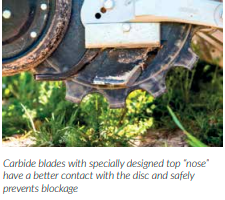
Creating the perfect opener has never been an easy task. Our machinery design is the result of 8 years of continuous development. One of our focus has been to simplify the daily use of the machine while increasing performance and output. User feedback allowed us to rework the T-Slot itself. We created a new blade shape in order to get rid of unwanted blockage, that were otherwise common on certain sticky soil types. In parallel we designed a new type of disc with smaller scallops, increasing penetration and accuracy in stony field or areas with hard clay contents.
The durability of the openers is one of Novag’s strength. The parallelogram joints rely on extremely long lasting, lubrication-free composite bushes. And regarding the other parts, a view at the frames speak for itself: nothing can go wrong.


The optimal T shape offers a smart solution to fertilizer placement, and, on top of this, is often the only process to obtain a well closed slot in all types of soils, including clay soils that are plastic and do not crumble. This factor alone is decisive for sowing in dry conditions and for protecting seeds against slugs, birds, and many others.
Planting through heavy straw
On straw covered fields, other notill technologies with discs all have hairpinning problems. Straw tends to catch the seed in a net, and thus it will not have a good enough contact with the soil. In addition, the decomposition of the straw will then release substances that will decrease germination.
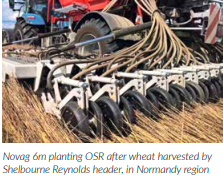
The seed placement with Novag machines is not affected by heavy residues at all, it is even made better by them. The straw still enters the furrow like with any disc drill but is not in contact with the seed thanks to the shape of the T. Because the seed is dropped by the blade and does not fall directly into the disc furrow.
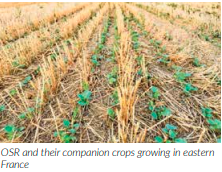
Yes, we know the possible alternatives to the T-SlotPlus. Why not removing the straw first, doing superficial tillage, using a high disturbance tined drills or” strip till” drills, cutting the crop “high” with the combine, following by sowing and then mowing/mulching…? These solutions generate more costs and/or slow down the process of soil improvement. Healthy soils lead naturally to healthy profits. With the Novag high yield no tillage system, you can restore high profitability to the farm. And, even more, there is the farmer’s personal health with less tractor hours.
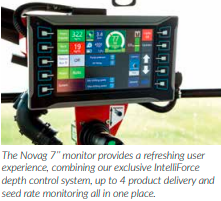
Electronics designed inhouse
Successful direct seeding starts by finding the right settings on the drill. Therefore, we created our own monitor and drill electronic system. There, all drilling parameters are shown in a unique way, focusing on pressure and seeding depth accuracy All models feature our exclusive IntelliForce depth control system as standard. This allows the drill to automatically handle changes in the soil type. The downforce in the opener cylinders is then automatically adjusted on the move, according to the soil resistance, in order to maintain constant seeding depth and perfect slot closure. Once you have tried this system, it is impossible to go back.
See you at Groundswell
This year is a premiere for Novag. For the first time a Novag machine will set foot in the United Kingdom, at the 2019 edition of Groundswell. So of course, we are focusing on the expectations of our British neighbors, who are facing many of the new farming challenges connected to weeds and soil health. Those same issues have already made their ways to our own French farms as well. We will keep posting in Direct driller following issues, with more detailed farmers (and earthworms) testimonial.
Let ‘s start gaining ground together! To read more scan the QR Code

-

Where Will The Beetle Go Next?
Charlotte Rowley, AHDB Crop Protection Scientist runs the rule over CSFB in 2019

If you are a regular Twitter user, you might be wondering how there is any oilseed rape left in some parts of the country following the onslaught of cabbage stem flea beetle this year. Pictures have been posted from across the country of OSR filled with larvae, and not just flea beetle but rape winter stem weevil too. This year seems to have been the perfect storm for flea beetle misery: newly sown crops unable to grow away in dry ground, and then a prolonged period of mild weather allowing egg laying and larval development to continue late into the season. In some areas this has resulted in high numbers of larvae, with 19 found in a single stem at a site assessed by ADAS. With the threat of spreading insecticide resistance and a need to look after our beneficial insects, tackling cabbage stem flea beetle has to go further than just another pesticide spray.

What’s in the pipeline?
This outbreak comes in the final year of a 3-year AHDB funded project into cabbage stem flea beetle IPM, led by researchers at ADAS in collaboration with Fera, Bayer, Syngenta and Cotton Farm Consultancy Ltd. This project is aiming for a truly integrated approach to pest management, investigating a range of factors including weather, seed rate, variety, alternative control options, and the effect these might have on flea beetle damage. One area of alternative control being explored is the use of volunteer OSR as a trap crop. Trap crops can be effective in drawing flea beetle and other pests away from the cash crop, but can also be expensive to sow and manage.
As part of their research, Steve Ellis and Sacha White at ADAS have instead been looking at the effectiveness of leaving volunteer oilseed rape in a field neighbouring this year’s crop to attract migrating cabbage stem flea beetle away from newly emerging seedlings. This work is based on a suspected biological quirk of cabbage stem flea beetle where their wing muscles deteriorate after the initial migration, making it difficult for them to move into another crop.
Not destroying volunteers until midSeptember therefore, could help to protect the cash crop during the main migration period. So far, the results from trials using this technique suggest that it can be effective if a large enough area of volunteers is left. We know that like many insect pests, cabbage stem flea beetle locate their host crop at long range by detecting certain volatiles given off by the plants. It makes sense then that there needs to be enough plants to give off a sufficiently strong signal to attract large numbers of migrating adults. This might limit the fields in which this technique can be used, but some forward planning could help create a large enough volunteer environment to protect adjacent crops.
Other points to consider
As with any integrated pest management strategy, suitability should be looked at on a field by field basis. Risk assessments of disease and erucic acid levels should come into play when thinking about management of OSR volunteers.
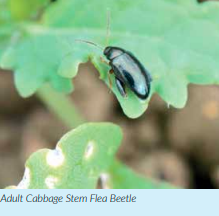
However, where this technique has proved effective, it has shown reduced adult numbers and increased plant populations in the adjacent new OSR crop.
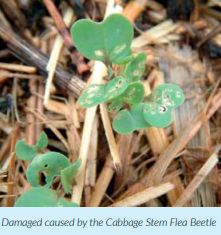
Early results from autumn 2018 also suggest lower larval numbers in the new crop – so keep an eye out for more results later this year. As well as trap cropping, the ADAS researchers have also been investigating defoliation over winter as a way of reducing larval numbers. Teaming up with Innovative Farmers, they have set up field labs to get farmers trying this out in tramline trials.
So far the results have shown promising reductions in larval numbers but time will tell whether there is an impact on yield in a particularly difficult year. Other avenues of research being looked at elsewhere include companion cropping OSR and the impact of natural enemies on flea beetle populations. Cabbage stem flea beetle larvae and adults are susceptible from attack by parasitoid wasps, so any insecticide sprays in spring or summer can be particularly harmful to these beneficial insects. These areas of research could all form part of a bigger IPM strategy, in time helping farmers to both reduce insecticide usage and overcome the challenges of cabbage stem flea beetle.
For further information, please visit: https://ahdb.org.uk/knowledge-library/ cabbage-stem-flea-beetle.
-

Size Matters
All that glitters is not gold. Harry Henderson, AHDB Technical Knowledge Exchange Manager
discusses the latest thinking in machinery costings.
With all the debates held at Monitor Farm meetings, which rumbled on about machinery costs a couple of spin-off debates came to fruition. A recent visit to Scotland found me standing in front of farmers talking to them about their machinery spend. There was a general assumption that ‘this Englishman’ was going to tell hardy Scots farmers to use tractors built in a country formerly part of the USSR and they should have kept hold of the 1983 Dominator combine that they fondly remember. Oh, and harvest your wheat at 14% moisture like us other Brits do and you’ll be in good shape. (Although I think I did gasp when one farmer calmly said, “You really have to stop combining when wheat gets to 35% moisture?”)
Of course I wasn’t born yesterday, and have learnt from walking into a hail of bullets in the past. So, my tack was to show the operation costs found across the Monitor Farm network and discuss how machinery costs vary so much and if your farm business can sustain these costs. In addition, using the average figure as benchmark, can your combine harvester come in at or around that cost?
Some good, open conversation came up with these thoughts;
• Were any of these costs something to worry about? In the current climate, not really.
• Are the higher costs unsustainable if farm support payments reduce? Quite probably.
• Do you need to finally accept that factory trip to the Minsk Tractor Works to see your next tractor? No.
• Should your combine be old enough to drink alcohol and vote before trading it in? Absolutely not.

Looking at the range of costs found across the Monitor Farm network showed that there’s always a back story. Take rolling after drilling, for example – the £4/ha cost on one farm revealed a Fendt 514 working across 500 hectares with a 12 metre set of rolls. The £21/ha operation cost revealed a 6150R John Deere working with a 6 metre set, across 230 hectares. The higher cost simply showed the output reduced by half due to working width and covering approximately half the area, while a similar sized tractor was used across both operations.
So it’s not the age of the machine, it’s the size and area it’s used across. Having said that, it goes without saying of course that reducing the cost, and therefore capacity of machinery carries its own risks; missing that vital weather window. Something Scottish farmers are all too aware of.
Looking at the range of costs found across the Monitor Farm network showed that there’s always a back story.
Looking at combining, the Scots waste no time in telling you they need high capacity and all condition threshing in a combine. The meeting attendees surmised that the combine costing £41/ ha, a 2003 machine cutting 539ha per year, was at too high a risk of a breakdown and potentially missing a vital weather window and ultimately missing harvesting quality grain. The combine at £97/ha took a direct hit on its costs, as it saw some serious winter maintenance last year. Arguably, these costs could have been spread over a couple of years – indeed the combine is staying on-farm for an extra couple of years at least as a result.
By using the costs generated at Monitor Farms across the country you can gain a reasonable benchmark cost for your own system. Taking the average cost, you are also able to consider if a new combine is affordable.
Looking at combining, the Scots waste no time in telling you they need high capacity and all condition threshing in a combine.
Look at it like this; the average farm, with a cost to business of £66/ ha and hectares to cut at 500 each year, means you have spent £33,000 on harvesting capacity, combine, fuel, driver the lot. Within that figure, there is enough to pay for a good combine at the right capacity for your locality and weather patterns. Understanding your cost of operation can go a long way to seeing you right and the truth may not be that painful.
To calculate your own costs, search AHDB Machinery Cost Calculator and use the calculations to see for yourself.
-

Soil Organic Matter
We are all in need of healthy soils but how can we create that magical organic matter cocktail,
Dr James Holmes from AHDB shares some simple advice on what to look for
Soil organic matter is a mysterious substance with legendary qualities yet practical guidance on how to manage it has been thin on the ground. A series of research projects funded by farmers and growers through the AHDB has shed light on this extraordinary material.

What is soil organic matter?
Soil organic matter (SOM) includes all living and dead plant and animal material. It includes the roots of newly sown and developing crops, stubble, manures and substances made and secreted by roots and soil organisms.
There are three main forms of SOM, at progressive stages of decomposition.
1. Fresh plant residues and small living organisms
2. Decomposing material, often called active organic matter
3. Humus, often referred to as stable organic matter
All SOM contains carbon but it also contains other plant nutrients such as nitrogen, phosphorus, potassium, sulphur and micronutrients.
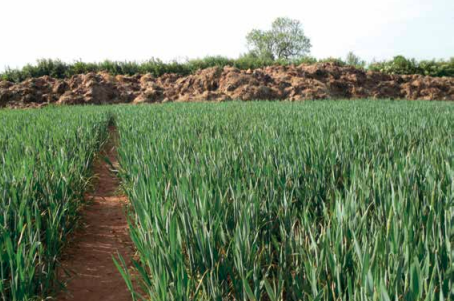
Does it really matter?
Applying organic materials, such as farmyard manure or compost is thought to improve soil structure by feeding soil organisms such as earthworms. However, results of historical trials have been ambiguous because materials such as compost supply not only organic matter but also nutrients that crops respond to.
Trials at Rothamsted Research have shown that applying farmyard manure can improve barley grain and straw yields within two years. Penetrometer assessments suggest yield is increased by improving root growth and exploration. It’s thought that organic matter added to soil feeds soil organisms that in turn improve the structure of the soil.
To help farmers improve soil management and benefit from soil organic matter, AHDB set up a series of trials from 2012 to 2016. The trials measured yields in response to fertiliser nitrogen with and without additions of either digestate, compost or farmyard manure. Comparisons were made between conventional tillage and reduced tillage as well as the ways in which different crops and crop rotations were affected by additions of organic matter.
Over the four years of trials, yields were consistently higher when an organic material was applied to a crop, as opposed to only an application of the same amount of nitrogen. This showed that organic matter, be that digestate, compost or farmyard manure, increased the yield of the crop by providing benefits in addition to nitrogen. Measures of the draft force needed to plough the soil suggest that organic materials improved yields by not only supplying nitrogen but by improving soil structure. Interestingly, a set of long-term trials have shown that applying organic materials mitigates the effects of soil borne disease and help maintain yield consistency from year to year. This resilience is important given the increasing fluctuations in weather that we are experiencing.
How do I measure soil organic matter?
Levels of SOM change relatively slowly so should only be measured every 3-5 years alongside routine analysis of soil phosphorus, potash and magnesium levels. A measurement of SOM matter is not normally included in the price of a routine soil analysis so it is important to tell the lab you would like it to be included. A lab will measure the percentage of SOM in your soil sample using either the loss on ignition or Dumas method. It does not matter which lab/method is used but as with all analyses it is important to use the same lab in the future so that you can compare results.
How much soil organic matter should I have?
Levels of SOM are measured as a percentage. Currently there are no agreed targets or ideal levels of SOM for different soil types. However, AHDB is testing a new system and has published preliminary SOM targets for different soil types, across different rainfall areas of England and grass or arable farms. Visit www.ahdb.org.uk/greatsoils where you can read a factsheet on Measuring and Managing Soil Organic Matter with supplementary information on appropriate levels of organic matter in soil.

How can I increase levels of soil organic matter?
Disruption of soil aggregates during tillage usually results in decomposition of SOM and a decrease in the percentage the soil contains. Where levels of SOM are low it can be increased by including cover crops in the rotation or by applying organic materials such as compost or farmyard manure.

Although the benefits of applying organic matter are becoming increasingly clear it is important to consider the cost of organic materials. AHDB research has shown that above the value of the nutrients it contains, it is rarely economic to spend more than a further £30/t/ ha (dry matter) on an organic material, including haulage and spreading.
Further Information
For more information on the topics above, please visit:
• Improvement of soil structure and crop yield by adding organic matter to soil: Search “AHDB Cereals and Oilseeds Project Report No. 576”
• Organic matter and soil management: ahdb.org.uk/greatsoils
• Nutrient management guidance: ahdb.org.uk/rb209
-
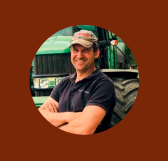
Farmer Focus – Tom Sewell
“Everyone copies and no-one thinks”

As I sit here in a Spain an hour north of Malaga in the mountains surrounded by Olive groves it’s a good time to think and reflect. I must admit I’m really not that good at doing holidays! Fortunately I have a wonderful wife who makes it a priority and to be honest it’s a good time to get away. At home the flag leaf sprays have been completed, all fertiliser applied and machines given a pre-holiday/pre busy-season wash & polish. We’ve also installed three 20 000 litre rainwater harvesting tanks to gather much needed water for spraying. As I take the occasional glance at social media, I see serious weather issues affecting the mid-west of America. Parts of Canada have had difficulties this spring and I’m sure there are other areas facing weather challenges too. This will no doubt have knock-on effects when it comes to our domestic commodity prices. With nothing sold forward the potential uplift in prices needs to be watched carefully!
The title of this article is a phrase I picked up from a farmer I met in Paraguay whilst travelling on my Nuffield Scholarship. “Everyone copies and no-one thinks” It’s a phrase I come back to often especially when I’m in danger of being affected by the latest trend sweeping the “twitter-sphere”!! There are two particular areas where a lot of “thinking” and a lot less “following” are required. These for me are the whole area of black grass and machinery inventory/requirements. If there’s one thing I seem to have become good at doing this year, it’s establishing a lovely crop of black grass! No matter what chemistry we have thrown at it we still seem to be fighting a battle.
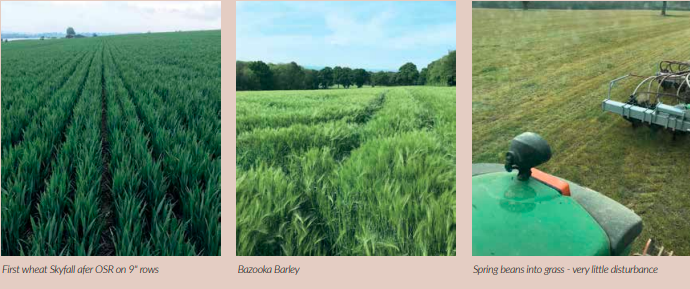
My reading material poolside this week has been “Dirt to Soil” by Gabe Brown. This book, for those of you who have yet to read it, challenges almost every farming pre-conception you have. Even over this week I have thought differently and made changes to my thought pattern regarding how we tackle soils and weed seeds. Consequently, we will now be planting a 12-way cover crop behind first wheat before spring barley to build soil health. Time will tell whether this is the right thing to do! My plan on a 100ha block of free draining medium soil will be to drill on the green and spray off post drilling. As for the issue of machinery, again Gabe Brown challenges our thinking. Having had the privilege of visiting “Browns Ranch” in North Dakota with Jake Freestone on our Nuffield travels, I can confirm that “shiny metal syndrome” is not an issue Gabe and Paul Brown struggle with! Certainly, a lot to be challenged by there!
I have recently thought that 3 tractors and a self-propelled sprayer on our acreage was inefficient and overkill. Looking at what other farmers covering more acres were doing I ought to be running two tractors and a trailed sprayer I thought. I really like the idea of a wider boom that follows ground contours better and a bigger tank. More acres covered per load and more timely applications particularly as we apply liquid fertiliser too (4 splits this spring) It’s a thought process that’s ongoing and really needs a few more acres to justify. Having said that my three tractors are all over 9 years old, in immaculate condition and have barely 10000hrs between them. They are all bought and paid for and allow capacity during harvest and haymaking plus the luxury of a “selfpropelled drill” which for planting cover crops this year may be a Godsend. My Dad is a first-generation farmer and has a great saying “we make money because we don’t spend money” Knowing when to spend and when to cut out inputs or do things a different way are part of the fun of farming.
But also knowing when to jump at an opportunity is a skill I need to improve upon!

The issue of cover crops has been nagging at me for the last year or two. When we embraced no-till 7 years ago we had some really successful catch crops and cover crops, but I think I got complacent and relied on volunteer regrowth to give green cover. Again, reading Gabe Browns book has reinforced the importance of diversity above and below ground. I have a hunch that combining this with a varied mix of spring and autumn sown cash crops will have a positive impact on our black grass control. A great quote from Gabes book is “without cover crops you’re going to spill the sun and waste an opportunity to boost the healing process”

As always, the future plans change! People ask me what my crop rotation is and I normally just shrug my shoulders as it changes on a weekly basis! We think we’ve got somewhere near where we want to be with a five-way rotation that includes 2 wheats, Oilseed Rape, Winter or Spring Barley and Winter or Spring Beans.
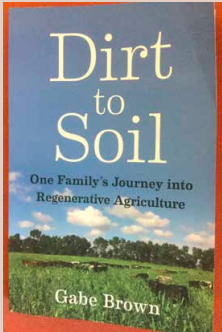
That gives opportunity for both catch crops and cover crops, a good workload spread and hopefully opportunity to build soil health. We’re moving into the show season and I’ll be attending Groundswell and Cereals this year. Looking forward to hearing some excellent presentations and seeing what’s on offer. Lots to think about, but who to follow?!
-

Drill Manufacturers In Focus…
NEW TO THE UK MARKET IMPORTED BY SAMAGRI LTD

Who are Virkar?
Virkar was set up in 2010 by three young entrepreneurs: an engineer, a mechanic and a farmer. We were looking for a no-tillage machine that was superior to the most prestigious machines on the market. Capable of offering high yield that no other machine can match right now, and able to meet the highest expectations and requirements in the sowing process. Virkar wishes to listen to farmers and at the same time provide a modern and technological outlook, thanks to its multidisciplinary team, to create high quality and reliable machines whilst keeping them easy to handle with a high degree of innovation.

The Dynamic drill
The Virkar Dynamic drill is available in 4.5/5/6 meter working widths with bigger sizes in development for the future.

The drill is semi mounted and has a hopper capacity of 5300lts. The drill comes on flotation tyres 550/45 22.5 which ensures compaction in field is kept to a minimum.

Sowing rate from 2 to 380 kg/ha is achievable from one feed roller.
Total contour system
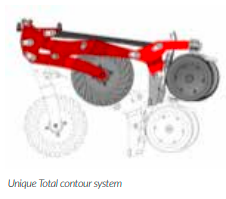
The modular coulter design consists of a turbo cutting disc, which is on a hydraulically pressured arm which ensures the turbo disc can cut a clean slot in the soil and create a micro tilth in front of the following seeding tine. Working independently from the turbo disc is a low disturbance seeding tine that not only places the seed at a very even depth, but because of its design the seeding tine cleans the slot of any trash leaving only clean soil in the slot, this means great seed to soil contact.
Following the seeding tine is a v shaped double press wheel which closes the slot. The drilling coulters are pressurised via a large accumulator all the coulters are linked together, this allows for very effective ground contour following with every coulter being able to travel up to 35 cm meaning even seed depth is achieved even in the most uneven terrain. Having the drill working off this accumulator means it is easy to change the pressure of the coulters, by a control box in the cab a dial is turned and from that more pressure is applied to the coulters which means even the hardest of ground is no problem to drill into.
Each coulter can apply 0/280kg of pressure to the ground. The seed depth is easily adjusted, the v shaped double press wheels are adjusted by a simple pull out pin the wheels can then be lifted, up or down and then the pin placed back meaning easy change of the depth.
Hopper
The seed hopper has the option of splitting the tank 65% seed 35% fertiliser running through 2 metering systems. In addition, liquid Fert can be specified as option. There is also the option of a third 600-litre seed-carrying element that can be dropped into the main hopper with a telehandler, where it is clamped in position. Free Drive the steering axle provides new freedom sowing on a curved path, the system frees up tension in the coulters arms meaning less stress is put on components leading to longer working life. Long life bushings for low maintenance, all sealed bearings on discs and press wheels so easy to maintain
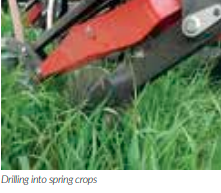
Control System
Easy Vario controls in a simple way an advanced hydraulic system to lift lower and adjust coulter pressure from control box in the cab meaning adjustments can be made easily on the move without need to stop meaning a more productive working day. The drill comes ISOBUS ready and the seeding part can run through the tractors terminal and be set up to undertake variable rate seeding if necessary.
Modular Design
Another feature that stands-out is the flexibility to alter row width and full working width. Both the 4.5m and 6m versions use the same chassis, so owners can simply bolt extra frames onto the wings and fit the required number of coulter modules. You can shift the row widths from 19cm to 25cm (or vice versa) by moving the coulter units into the different predrilled slots on the frame.
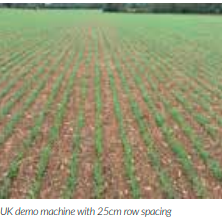

Lastly if you’re thinking about sowing oilseed rape at 50cm centres, it’s a simple case of lifting the front row out of work.
Requirements
The Dynamic drill is very easy to pull because of its low disturbance meaning a 6 meter drill can be pulled by 180hp. The drill requires 4 spools if fitted with hydraulic drive for fan or 3 spools if drill is fitted with PTO pump to run the fan. It comes standard with LED work lights, tank lights, a decent size toolbox calibration bag and scales.
Summary
The Virkar drill offers users with a no till drill that is very flexible and can also work in min till systems just as well as it can in no till systems. The drill offers users with the flexibility of being able to drill in the toughest of conditions. Unique features such as the hydraulically powered cutting disc the steering rear axle and ease of operation makes the Virkar a seriously attractive drill for the modern farmer looking to invest in a machine that will serve them the same today as it will 10 years down the line.
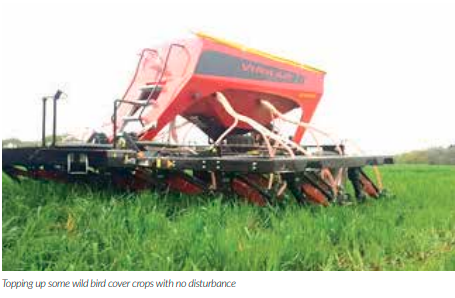
For more information, scan the code below.

-

NIAB Project: Building Fertility In Soils
The use of inorganic nitrogen is key to maintaining fertility and yield in conventional arable systems. However, inorganic nitrogen is an energy rich product that is becoming increasingly expensive. With the assistance of The John Oldacre Foundation, research within NIAB TAG is exploring the potential of bi-cropped legume species to be integrated into modern conventional farming systems (e.g. clover grown along with wheat as an inter-crop).

This is being carried out with a view to reducing bagged nitrogen requirements and building yield potential and longer-term fertility on thin Cotswold brash soils. One of the key issues is the reliable establishment of both species and the persistency of clover within the system over the length of the rotation. This study is looking at clover established in year one (from timings ranging from August through to mid September) and wheat establishment (timings from mid September through mid October) in both years one and two as well as examining the interaction with applied nitrogen dose. While data from this ongoing research programme has shown variation, there is an increasing suggestion that positive yield responses to clover intercropping are possible at lower nitrogen doses. This may become increasingly relevant as the price of inorganic nitrogen continues to rise.

We will publish more information when it is available.
-

Crop Protection Products: Part Of The Modern Farmers’ Toolkit
Written by Ralph Early, Independent Food Scientist and Food Ethicist
In the first of a two-part article, Ralph Early discusses the historical and current use of crop protection products and
focuses on the use of herbicides and insecticides
Introduction
Over millennia humans have established a particular relationship with the species they categorise as pests and it is a distinctly anthropocentric relationship. Pests threaten the quality of human life and existence, and in this lies the justification for their control and eradication as a common good benefiting humans as individuals and society as a whole. Farmers, more than most people, understand the importance of controlling pests for uncontrolled they present a constant threat to crops, farmed animals, stored materials, processed food products and premises. To illustrate, the FAO (Food and Agriculture Organisation) estimates that between 20 and 40 percent of world crop yield is reduced by pests and diseases (FAO 2015).
Pest control in food production is then vitally important, but it presents particular challenges in relation to effective and safe methods of use, environmental protection and ecological effects. This article presents a snapshot of pest control in agriculture by means pesticides. It is a topic of great importance and one about which a vast literature exists, considering such as the wider benefits of pesticides in the context of humans and the environment (e.g. Cooper and Dobson, 2007) as well as research of a very specific nature.
Historical perspectives
Pests compete with human beings for the resources necessary to survival and in some instances people are the resource. Early farmers would have sought the means to control agricultural pests and people generally would have innovated solutions to more personal problems such as fleas and body lice. Pyrethrum, derived from the flower heads of Chrysanthemums, Chrysanthemum cinerariifolium and Chrysanthemum coccineum, was used as an early form of insecticide and it is still used today.
Toxic compounds based on mercury and arsenic were used to combat infestation by the body louse, Pediculus humanus humanus, and head louse, Pediculus humanus capitis. Sulphur compounds were also used to control insects and mites in domestic and agricultural situations. Some 3,500 years ago the Chinese innovated the use of botanical compounds as insecticidal seed treatments and around the same time the ancient Egyptians used cats to control rodents threatening stored grains. In 1200 BCE the Chinese were utilising biological methods of pest control with predatory ants eliminating beetles and their larvae.
The human need to control pests clearly stretches back into history, but scientific pest control and specifically the protection of agricultural produce has progressed most rapidly over the last century and a half, as a consequence of advances in industrial chemistry. As urban populations grew during the 19th century demands on rural food production increased. Watson (2018) records the history of the development of pesticides and the pesticide industry explaining, for example, that many compounds used as early, non-selective pesticides, such as copper acetoarsenite, or Paris Green, a toxic dye, were by-products of industrial processes. Other substances used as pesticides included compounds of arsenic, mercury and sulphur as well as nicotine and hydrogen cyanide. Clearly such pesticides were as potentially lethal to those who used them as to the pests they were intended to destroy.
During the early 20th century a number of notable industrial chemical companies identified the market opportunities that an increasingly mechanised and industrial agriculture offered. These companies were transformed into agro-chemical businesses serving agriculture, first in economically developed countries in Europe and North America, but also other parts of the world as the century’s Green Revolution gathered pace.
It is interesting to note that some of the leading agro-chemical companies of the 20th century developed their expertise in pesticide chemistry as manufacturers of chemical warfare agents. Organophosphorus compounds, for example, act on the nervous system of mammals and insects inhibiting irreversibly the enzyme, acetylcholinesterase. This causes the neurotransmitter acetylcholine to overload the nervous systems of affected organisms with constant transmission of signals between motor neurons, resulting in eventual death. The nerve agent Novchok, a topic of international news in 2018, is an organophosphatebased compound. Other examples include Tabun, based on insecticide development by the German chemical company, I.G. Farben, in 1936, and VX, a nerve agent developed at Britain’s Porton Down defense laboratory in the 1950s and based on the organophosphate insecticide, Amiton.
Modern Pest Control
In relation to modern pest control, Watson (2018) defines the period 1930 to 1973 as the Productivist Period, during which many functionally valuable pesticides came into use. The foundations of today’s monoculture agriculture were formed during this time, as engineering and seed companies recognised the commercial opportunities to be gained by collaborating with agro-chemical companies in the intensification of agriculture and food production. Innovations in engineering, plant breeding, fertilisers and pesticides were aligned to support farmers in the challenges they faced, not least being pests.
Farmers who are engaged in crop production seek to control mainly invasive plant species (weeds), insects, nematodes and the fungal diseases of crops as well as rodents, other small mammals and birds. Those involved in animal production face similar problems when growing e.g. fodder crops, but they also need to control insect and parasitic pests of farmed animals as well as disease-causing microorganisms. The benefits of pest control are primarily increased crop and animal yields with associated increases in harvested product (crops and animals), improved product quality and the control of invasive species. Additionally, the use of pesticides (and drugs) in animal production brings improvements in animal welfare by the alleviation and elimination of animal suffering.

Agricultural pests require treatment with specific pesticides which are classified according to the pests they eliminate. In the context of British farms this generally means herbicides, insecticides, nematicides, fungicides, bactericides and rodenticides.
Herbicides
Herbicides, also known as weed-killers, can be conveniently divided into two groups: selective herbicides and nonselective herbicides. They are also defined according to stage of use in the crop cycle: preplanting, pre-emergence, post-emergence and established stands. Different herbicides have different modes of action (MOAs). Some herbicides disrupt cell division and are generally used for pre-emergence applications with germinating seeds, while those that disrupt photosynthesis are used post-emergence. Herbicides that target specific enzymes are designed to treat different plant species, from grasses to broad leaved weeds, and are used on established plants, for instance to prepare ground for cultivation and/or seed drilling.
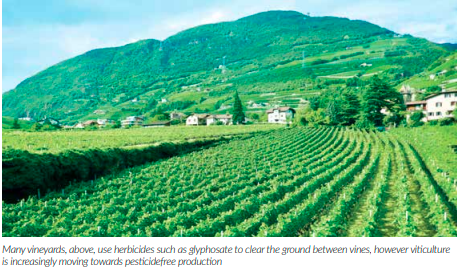
Selective herbicides are formulated such that they are effective against weeds growing among a given crop, e.g. broad leaved weeds or grasses growing alongside maize and pulses. The organic compound 2,4-D (2,4-Dichlorophenoxyacetic acid) functions as a systemic herbicide. It is absorbed into plants where, as a synthetic auxin (growth hormone), it stimulates uncontrolled growth resulting in death. It leaves cereals and grasses unaffected. As a herbicidal compound it is the active ingredient in many proprietary products and has been used as a defoliant since the 1940s. During the Vietnam war 2,4- D was weaponised along with 2,4,5-T (2,4,5-Trichlorophenoxyacetic acid) as ‘Agent Orange’ in the USA’s herbicidal warfare programme. Unfortunately Agent Orange was contaminated with dioxins, now linked to abnormally high incidences of cancer such as leukemia and non-Hodgkin lymphoma as well as birth defects among the Vietnamese people.
Non-selective herbicides are formulated to kill both grasses and broad leafed weeds. Two examples are, paraquat (N,N′-dimethyl-4,4′- bipyridinium dichloride) and glyphosate (N-phosphonomethyl-glycine). Paraquat obstructs photosynthesis and was used widely for many decades as a very effective non-selective foliar contact herbicide. However, it is extremely toxic to humans and other mammals, and has been banned in the EU since 2007, as well as other countries. Glyphosate, in contrast, is the most widely used herbicide in the world with some market research agencies projecting sales of US$ 8.5 billion by 2020.
It is as an extremely effective herbicide, favoured by British farmers as a means of controlling blackgrass (Alopecurus myosuroides) and as a desiccant on cereals before harvest, although herbicide resistance is appearing in blackgrass (HGCA, 2008). Matthews (2018) provides a detailed review of pesticides and their use, noting that many newer products have entered the market since 2000 including propoxycarbazone-sodium, which is effective against blackgrass, other grasses and some broad-leaved weeds in wheat. Given the need to develop methods of sustainable agriculture, broad-spectrum herbicides have found favour in no-till cultivation which aims at preserving soil quality and reducing soil erosion and loss caused by cultivations.
Glyphosate functions by blocking the enzyme enolpyruvylshikimate-3- phosphate synthase in the shikimic biosynthetic pathway of plants responsible for the production of aromatic amino acids and other metabolites. Human beings and mammals do not possess the pathway, so glyphosate is considered non-hazardous to human health. In 2015 however, the WHO’s cancer research agency declared glyphosate a probable carcinogen although various studies e.g. Mink et al (2012) have not revealed an association between glyphosate and sitespecific cancer. In 2018 a California court awarded damages against Monsanto in a case concerning cancer and the glyphosate-based herbicide, Roundup™. Recent research (Motta, Raymann and Moran, 2018) suggests that glyphosate may be harmful to bees, perturbing gut microbiota and adversely affecting bee health and effectiveness as pollinators.
Insecticides
A wide range of compounds have been and are used as insecticides. Natural insecticides include pyrethrum, nicotine and neem. Synthetic insecticides include organochlorides such as DDT (Dichlorodiphenyltrichloroethane), organophosphates and carbamates, neonicotinoids and pyrethroids. Different insecticides have different modes of action. For example, DDT interferes with the function of cellular sodium channels; organophosphates interfere with the function of acetylcholinesterase. As the agricultural use of organochlorine and organophosphate pesticides increased as a consequence of the 20th century’s Green Revolution, concerns were raised about effects on human and animal health.
Rachel Carson drew attention to the hazards inherent in the use of pesticides and particularly DDT (Carson, 1962), which began to focus the attention of public health authorities on the nature and effects of these substances. Studies of global wildlife in the 1960s and 1970s revealed bioaccumulation in body tissues and biomagnification in the biological food chain of various toxic compounds of industrial origin, such as PCBs (polychlorinated biphenyls) and some widely used pesticides. DDT proved to be an environmentally persistent organic pollutant detected in the tissues of many wildlife species, resulting in it being banned or restricted in many countries. It is very effective against the malaria carrying Anopheles mosquito and use is permitted in some countries.
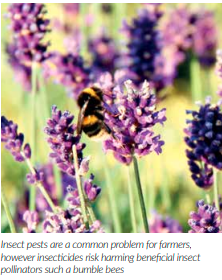
The application of pesticides to food crops involves the intentional application of toxic substances to materials destined for human consumption. Caution must therefore be taken with regard to the toxicity of pesticides, rates of application and the persistence of residues within the environment and on the foodstuffs to which they are applied. In this respect, farmers are provided with explicit recommendations regarding use and application rates in order to ensure that at the time of harvest Maximum Residue Levels (MRLs) are not exceeded. Even so, history has shown that pesticides which were presumed to be safe for use were not so. Dieldrin, for instance, an organochlorine insecticide used commonly in the mid-20th century was banned by the Stockholm Convention on Persistent Organic Pollutants. It proved to be carcinogenic, an endocrine disruptor and harmful to the nervous system of humans, among other effects, and does not readily degrade, remaining active in the environment for many years.
More recently controversy has arisen in relation to a class of systemic agricultural insecticides resembling nicotine, termed neonicotinoids, which have proven very effective insecticides, for example, in the prophylactic protection of autumnsown oilseed rape (Brassica napus L.). However, Whitehorn et al (2012) report harms to bumble bee colonies caused by neonicotinoids and similar findings have been obtained by various workers. Consensus on the effects of neonicotinoids is though incomplete as others have been unable to draw definitive conclusions (EFSA, 2012). Concern about the effects of neonicotinoids on insect pollinators, including Apis melifera, the honey bee, has led to the banning of three in the class, imidacloprid, clothianidin and thiamethoxam, for outdoor use in the UK by the end of 2018. Other neonicotinoids, such as thiacloprid, are still permitted.
Conclusion
Crop protection products are an important tool in the agricultural production of food. The tool is not however without controversy, because of associated possible harms to the environment, wild biodiversity and human beings. Part two of this article will consider the other main classes of pesticides – fungicides, nematicides and rodenticides – together with policy perspectives and a view of the future encompassing alternatives to pesticides, precision farming and the ethical aspects of pesticide use.
This article was originally published as ‘Pesticides in Agriculture’ in Food Science and Technology, the journal of the Institute of Food Science and Technology. If you would like to read the references for this article, you can do so on their website by scanning the code

-
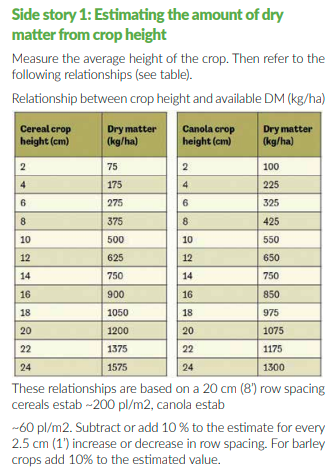
Grazing Wheat
Part 4 of the series on grazing cereals which is something being widely practiced across Australia in areas with widely
varying rainfall levels. The Australian Grain Research and Development Council have produced a report titled Grain and
Graze which sets out to evaluate the advantages and disadvantages of grazing a range of cash crops. We begin serializing this report over forth coming issues to explore what is currently an untapped resource.Estimating how much dry matter is available
There are two methods to estimate the amount of dry matter available in a crop. The first method uses a simple relationship between crop height and dry matter (see side story 1). This approach is applicable in high rainfall regions where seeding rates of 80 to 100 kg/ha and narrow row spacing (15 to 20 cm) are used. In regions where row spacing is wider that 20 cm, seeding rates are lower and plant establishment is more variable, then the second method should be used, where crop cuts need to be taken (see side story 3).
When to start grazing
Deciding when to start grazing is the first consideration. Once the plants are anchored and have grown secondary roots the crops can be grazed. This usually occurs around the three leaf stage for cereals but may not if dry conditions are encountered after germination. To ensure adequate anchorage, apply the ‘pinch and twist test’ (side story 3). For canola it is recommended to commence grazing at the six to eight leaf stage when plants are well anchored but before the buds elongate more than 10 cm.

Ideally there should be 500 kg/ha to 800 kg/ha of dry matter per hectare for sheep (1000 kg/ha for cattle) to achieve high levels of animal performance. However in reality most crops may not have reached this amount of growth before grazing commences (refer to section 1). Postponing grazing until this benchmark is reached will limit the grazing opportunity for those who wish to minimise the impact on subsequent grain yield.

Grazing before these benchmarks is feasible although there will be a decrease in animal performance (table 1).

Withholding periods with herbicide
Some pre and most post emergent herbicides, seed treatments and many insecticides and fungicides have a withholding period from grazing after application. These can be as long as 15 weeks which can severely limit the grazing opportunity. Therefore, the timing of grazing and spraying operations need to be considered together. (A range of common herbicides used in crops for seed treatments, pre and post emergent weed control, fungicides and insecticides and their withholding periods is provided)
Grazing may improve the efficiency of weed control. For example, the use of grazing may enable certain broadleaf weeds to be controlled using a combination of a lower rate of herbicide with grazing (spraygraze technique).
A recent note posted on the Department of Agriculture and Food website in Western Australia reinforces the need to follow grazing withholding periods:
• The grazing withholding period (GWP) is the minimum time between chemical application and harvest for stockfeed or grazing to ensure the maximum reside limit (MRL) and/or export grazing interval (EGI) are not exceeded
• GWP are not about avoiding poisoning grazing animals, but ensuring animals are free of violative residues at slaughter
• It is a legal requirement to observe the GWP
• It is a requirement of ChemCert accreditation and Livestock Production Assurance (LPA) programs that chemical records are kept of when crops and pastures are treated, and of when grazing withholding periods expire.
How hard to graze
Deciding how much crop to leave behind can be contentious because it is a trade-off between maximising the feed on offer against the potential harm to grain ear formation and crop recovery. Earlier recommendations have been to graze the crop ‘to the white line’ (see side story 4) but subsequent work has shown this increases the risk of encountering a grain yield penalty, especially if conditions after grazing are not favourable. Under favourable recovery conditions, which is more likely in the higher rainfall areas, heavy grazing is less risky. The current approach used in lower rainfall areas is ‘clip’ grazing.
Clip grazing
This method involves a light grazing of the crop, with just the top few centimetres of the crop canopy removed. This is in contrast to the more traditional ‘crash’ grazing where a crop is heavily grazed, with the vast majority of the crop canopy eaten. Clip grazing can reduce the risk of incurring costly grain yield penalties in dry seasons and lower rainfall areas. This is achieved by leaving more leaf area for recovery after grazing, enabling the crop to produce more biomass by flowering. Biomass at flowering is a key determinant of eventual grain yield. Clip grazing also enables a crop to better compete with weeds post-grazing.

When to stop grazing
When to stop grazing is the third important decision. There are two parts to consider, firstly knowing when the plants commence stem elongation (GS 30) and secondly allowing sufficient time for plant recovery to ensure grain fill.
Growth stage 30
It is currently recommended that grazing with sheep is completed by GS 30 if the aim is to minimise the risk of grain yield loss (see side story 5). For cattle, grazing needs to be completed before GS 32 is reached because they do not graze as low.
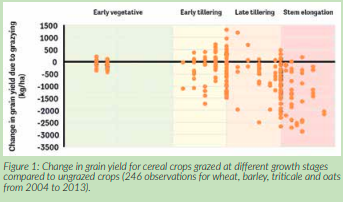
Grazing can continue after these benchmark growth stages, but the chances and magnitude of the loss in grain yield increases dramatically (figure 1). For regions where crops are sown purely to provide dry matter (DM) for grazing, there is no need to worry about damaging the embryonic ear of the plant.
Figure 1 clearly shows the increased chances of grain yield loss if grazing occurs after the start of stem elongation (reproductive growth). Grazing after the plant begins stem elongation risks damaging the ear.

Unfortunately, predicting the changes in crop development cannot be determined by a date on the calendar (although crops with a winter habit are more predictable). Visual observation of the emerging embryo ear is the only way to accurately assign this growth stage of a crop. There is a common referencing system that helps describe the development of a cereal plant from germination through to ripening. It consists of ten (10) development phases from zero to nine (0 to 9). Within each development phase there are up to ten (10) individual growth stages. This gives a two number code and is prefaced with the letters GS for growth stage. When making decisions about grazing winter crops, the change from GS 2 to GS 3 is critical. GS 2 refers to the development phase when the plant is tillering or producing stems at each crown. GS 3 refers to the development phase when the plant stops tillering and the embryo ear which has formed in the base of each tiller begins to move up the tiller. This phase is also characterised by each tiller beginning to thicken into stems, and nodes forming low down on each tiller. The key growth stage observations to accurately determine a growth stage are described (table 2 and side story 5).

A plant in vegetative growth with a main stem and four tillers would be described as GS 24. The same plant would be described as GS 31 when the ear is about 2 cm above the base of the plant, a hollow is forming beneath the ear and a ring or node is forming about 1 cm above the base of the plant. The method of dissecting a plant to test for growth stage is described (see side story 5).
Crop recovery after grazing
Stresses on the crop after grazing can affect plant recovery and grain yield. Moisture deficiencies and high temperatures can restrict regrowth of leaves and the aborting of tillers in the period up to flowering. The importance of these influences is being examined in the current Grain and Graze 3 program.
While there is no way of predicting what conditions may prevail in the period between grazing and flowering, limited soil water at grazing will increase the risk of a yield loss, even in the high rainfall zone. Observations from a trial in South West Victoria during the 2006 drought shows a dramatic reduction in grain yield of two long season wheat varieties compared to the ungrazed crop, even though GS 30 had not been reached. Soil moisture probes indicated the crop had reached wilting point (no soil moisture available for plant growth) during late August, so despite grazing before GS 30, crop recovery was poor which led to lower grain yield (figure 2).
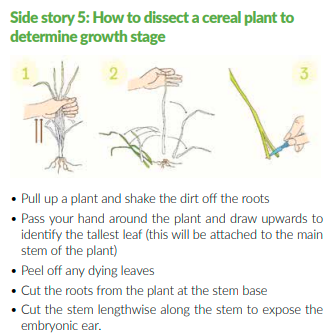
Modelling by the CSIRO6 for the high rainfall zones in Western and Southern Australia provided an indicative end grazing date for winter type wheats sown in mid-March, Mid-April and Mid-May which would enable enough time for crop recovery before flowering (figure 3). The end grazing date was determined when GS 30 was reached or when only 200 kg/ha of crop dry matter remained after grazing (grazed at 25 DSE/ha, commencing when 1000 kg/ha of dry matter was available). However field experience would suggest earlier end of grazing with later sowing dates may be wise.
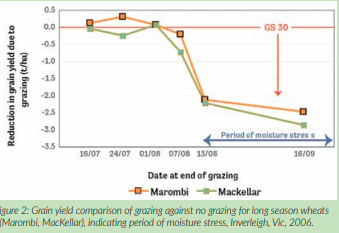

Delay in crop maturity
Grazing delays the maturity of a crop. Trial data would indicate the delay to maturity is between three and 14 days, although this will vary depending on when grazing commences and the duration of grazing. In Western Australia, where crops are grazed early, the common rule is 1 day of delay in flowering for every two days of grazing7. So a crop grazed for 20 days would have flowering delayed by approximately 10 days. In areas where crops are grazed later, delayed grazing delays maturity more so than early grazing (figure 4).
Delayed maturity has both positive and negative implications. If the crop cannot be grazed evenly there will be variability in crop ripening, which may create difficulties at harvest, especially with barley which is prone to drop grain heads when mature. On the positive side, grazing may be used strategically to delay flowering that may avoid damage caused by late frosts. Yet it may push maturity into a period of late moisture and/or heat stress.

-

Bridgeway Amino Acid Tramline Trails At TWB Farms
While helping put together the last issue of Direct Driller magazine we were proofreading the article about Interagro’’s
Bridgeway Biosimulant product which you can read about further by scanning the codeThe results claimed for this product in winter wheat last year were impressive. We felt they needed to be put to the test on the farm, so with a similar methodology to the BASF fungicide Adexar trial in 2016, we started a few tramlines trials – onfarm R&D to measure if it really can perform as well on our soils as in the range of results they found in 2018 which can be read about on the Interagro website. The plan here is to try it at various combinations and timings over several fields. It is claimed to work by helping crops through stress, so given the generally very dry conditions of spring 2019 experienced so far, that claim can be tested this season We have set up x 6 split fields – 4ha in each field The standard recommended rate of 2L /ha will be used at all applications

Yield will be mapped and calibrated against our weighbridge much like the Adexar trial we did which was deemed statistically significant by the ADAS Agrimetrics team at the time. The added resolution of data from the yieldmeter on the combine helped with the data analysis as well. We will also test protein levels as there are claims with regard to improved quality and take Brix readings to look at plant health throughout the season
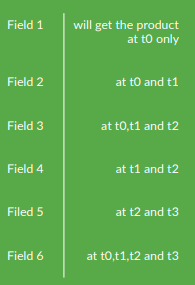
On May 14th tissue samples the plots treated so far with t0 and T1 timings. There is no visual difference that to see either by eye or on any satellite NDVI images we have so far. It’s fair to say the plots have been through some stress over the very dry period we had. Samples were taken from treated and untreated areas of the fields and Brix levels compared (a number of randomly picked whole leaves (leaf 2) blended with a coffee grinder and then tested with an electronic meter) Brix test results are interesting and frankly quite surprising to the sceptic in me, it does seem to show consistent Brix increase in line with the qty applied.
The ‘Bank’ field is the lightest soil in this trial (sand over gravel) that would have been the most stressed by the dry conditions and that is where we can see by far the biggest increase in Brix level. The same tests will be repeated again here between t2 and t3 applications and then again after t3 hopefully. However, the weighbridge at harvest will however be the ultimate judge of this trial!
